- Home
-
SHOP ECO FARM
- ECO Farm Grow Lights
- ECO Farm LED Grow Lights
- ECO Farm Quantum Board
- ECO Farm Samsung LED Grow Lights
- ECO Farm COB Grow Lights
- ECO Farm Commercial Lights
- ECO Farm Supplemental Grow Light
- ECO Farm Fluorescent grow lights
- ECO Farm HPS & MH Grow Lights
- ECO Farm CMH Grow Lights
- ECO Farm HID/CMH Bulbs & Ballasts
- ECO Farm Grow Tents & Kits
- ECO Farm 2x2ft Grow Kits
- ECO Farm 3x3ft Grow Kits
- ECO Farm 3.3x3.3ft Grow Kits
- ECO Farm 4x4ft Grow Kits
- ECO Farm 5x5ft Grow Kits
- ECO Farm Grow Tent - Standard Style
- ECO Farm Grow Tent - Extension & Roof & Lodge Style
- ECO Farm Extraction & Harvest
- ECO Farm Rosin Press Machine
- ECO Farm Dry & Wet Trimmers
- ECO Farm Oil Accessories
- ECO Farm Medicinal Plants Grinder
- ECO Farm Medicinal Plants Containers
- ECO Farm Medicinal Plants Dryer
- ECO Farm Refrigeration Dryer
- ECO Farm Climate Control & Other Accessories
- ECO Farm Inline Duct Fans
- ECO Farm Oscillating Fans
- ECO Farm Exhaust Fans
- ECO Farm Air Filter
- ECO Farm Duct Muffler
- ECO Farm Ventilation Kits
- ECO Farm Plant Humidifiers
- ECO Farm Plant Dehumidifiers
- ECO Farm Hydroponic Accessories
- ECO Farm Other Accessories
- ECO Farm Hydroponics Microscopes
-
TOP BRANDS
- Grow Lights Brands
- Adjust-A-Wing
- Apollo Horticulture
- Bestva
- Black Dog LED
- California Lightworks
- ChilLED Grow Light
- Eco Farm
- HLG - Horticulture Lighting Group
- Kingled
- Kind LED
- Mars Hydro
- Morsen
- Neilo
- NextLight
- Phlizon
- PlatinumLed
- Roleadro
- Optic LED Grow Lights
- ViparSpectra
- Vivosun
- EYE Hortilux
- IPOWER
- NanoLux
- Phantom grow light
- Gavita grow lights
- Grower's Choice
- Lumatek
- Maxibright
- Yearld Pro
- ThinkGrow
- Crecer Lighting
- Green Sunshine Electric Sky
- fohse aries
- loriflux
- luxx
- fluence
- iluminar
- Lex
- LTC
- Rayonled
- FGI
- PHOTONTEK
- Grow Tents & Kits Brands
- Apollo Horticulture
- Black Box
- CoolGrows
- Eco Farm
- GrowLab
- Gorilla Grow Tents
- Mars Hydro
- Quictent
- Secret Jardin
- Unit Farm
- TopoGrow
- VIVOSUN
- Topolite
-
COMPANY INFO
-
COOPERATE WITH US
- Blog
The Ultimate Guide to the Best LED Grow Lights for Indoor Plants (2023 Updated)
December 05, 2022
There are several different types of grow lights available for indoor plants. These include LEDs, metal halides and high-pressure sodium. Learn how to use each type to help your houseplants grow. Plus, learn about the pros and cons of each type. Ultimately, these lights will help you grow your plants and keep them looking their best. Today, LED grow lights are more popular than other grow lights. Now, we will introduce the best LED grow lights in 2023.
How Plant Grow Lights Work
Plants convert light energy into food using a process called photosynthesis. Some plants can thrive in low light conditions, while others require direct natural sunlight to thrive. Different types of plants may also require different amounts of sunlight throughout the day. Some people only need 8 hours a day, while others may need as many as 18 hours a day.
Certain plants grow best in different wavelengths of light, which can vary throughout their lifespan. Light from the blue end of the spectrum will help the foliage grow. Flowering and fruiting plants need light from the red end.
The best grow lights are designed to provide full-spectrum light to your plants. Therefore, they can photosynthesize and thrive in the same wavelengths of sunlight. Different grow lights can offer different spectral ranges. So, depending on the crops you grow, your lighting needs may vary.
ECO Farm Z8–800 Samsung LM301B LED Grow Light

Features:
The ECO Farm LED grow light is equipped with SAMSUNG LM301B chip and 8 high-efficiency aluminum rods to ensure high-efficiency PPE 2.7umol/J, better heat dissipation, and long service life. Compared with old plant lights, the average PPFD is increased by 30%, and the yield and quality are increased by 50%. 8 LED growth lights, each rod is covered with high-grade glue, waterproof and easy to clean, not easy to be filled with dust. This plant growth light also uses a special dimmer, which can precisely adjust the brightness. 0–10 levels are optional. This means that you can see clear brightness levels and record while adjusting. No need to worry about differences. At the same time, it also has an ideal full-spectrum and amazing heat dissipation: excellent full-spectrum mixing of white, blue, red, and ultraviolet light, IR LED (3500K, 660nm and IR 760nm & 396nm UV), close to natural sunlight. The spectrum applies to the entire stage of indoor planting.
Spider Farmer G860W Full Spectrum LED Grow Light

Features:
This Spider Farmer LED Grow Light features an even peripheral PPFD score for even coverage, ensuring maximum light per plant. The elongated light bar design also ensures a more even distribution of light, reaching all edges and corners. The strip grow light design and the aluminium heatsink on the back contribute to better airflow and good heat dissipation. The G860W Garden Light features a detachable driver and 6.56" long power cord to reduce ambient heat in the grow space for longer life. The LED diodes are coated with water repellent, so they are not afraid of a wet environment. Dimming daisy-chaining allows you to link up to 60 G680W Series grow lights together — dimming multiple lights simultaneously. Widely used in commercial cultivation, vertical farming, home gardens, home cultivation, CO2 systems and hydroponics.
Luxx 860w LED Pro XR LED Grow Light
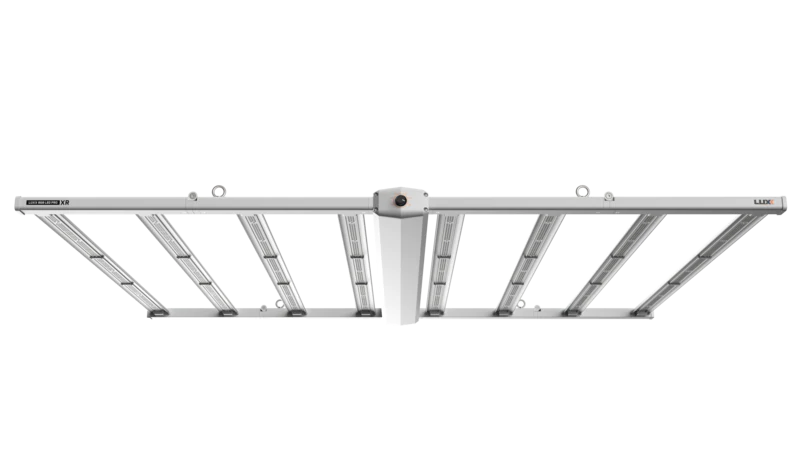
Features:
The Luxx grow light features two additional 100W LED bars to increase total light output and maintain PPFD uniformity over a larger area ensuring consistent growth across 5–6ft tray widths. The 860w LED Pro XR deploys a lens angle of 120 degrees, from an 8 bar design. The bar layout used by the Luxx 860w LED PRO XR enables the fixture to be placed close to the canopy maximizing PPFD while the array of bars provides light coming from multiple locations at different angles to penetrate the canopy. This maximizes the absorption of light by plant leaves, increasing the effectiveness of the light and reducing wasted photons.
Precautions for choosing LED plant growth lights
Before you go out and buy grow lights, there are a few things you need to consider. The best grow lights for your neighbor may not be for you.
Budget — Start by asking yourself “what is my budget?” While you can buy LED lights for pretty cheap these days, we always recommend getting the best you can afford. Don’t try to buy the cheapest light you can find. As with most things, you get what you pay for when it comes to cheap LED grow lights. That said, if you’re on a tight budget, there are affordable grow lights that perform well.
Space — Grow LED lights come in many shapes and sizes. Obviously, it is important to measure the surface area to be covered by the lighting system. Don’t forget to measure your available height.
Plant Varieties — What are you going to grow? The LEDs you choose for your average vegetable grow light aren’t necessarily the same as the best pot lights.
Planting method — how are you going to grow the crop? Are you looking for the best hydroponic grow lights? Do you want the best grow lights for seedlings or flowering? Are you looking for the best LEDs for plants grown in the Ocean of Green (SOG) style? The answers to your questions will lead to different grow light options.
Conclusion
If you’re looking for an efficient, inexpensive, and effective way to provide your indoor plants with the light they need to thrive, LED grow lights are a great choice.
Best LED Grow Lights for Indoor Plants of 2023(Buying Guide)
November 26, 2022
If you are looking for the best LED Grow Lights, you are in the right place. In this comprehensive review, we’ll take a look at some of the best options on the market and help you decide which one is best for your needs. Whether you are a beginner gardener just getting started with indoor gardening, or one looking to upgrade your current setup, we have you covered. So without further ado, let’s get started!
Do LED grow lights affect plants?
The different colors of LED grow lights are directly related to their intended use. Studies have shown that certain colors affect plant growth by affecting root and flower formation (blue and red light spectrum).
This means that most plant types will grow normally if exposed to blue and red grow lights. Adding other colors to the spectrum, such as green, far red, and dark blue, aids this process by giving the plant more information about its surroundings, making the plant better overall.
A spectrum with all the colors is called “full spectrum” and it looks mostly like sunlight, if it has a lot of green our eyes see it as white. This isn’t necessary for growing plants, but it does make working with the lights easier and lets you see the plants to inspect them.
ECO Farm ECOZ PRO 1000W Samsung 301H Chips LED Grow Light
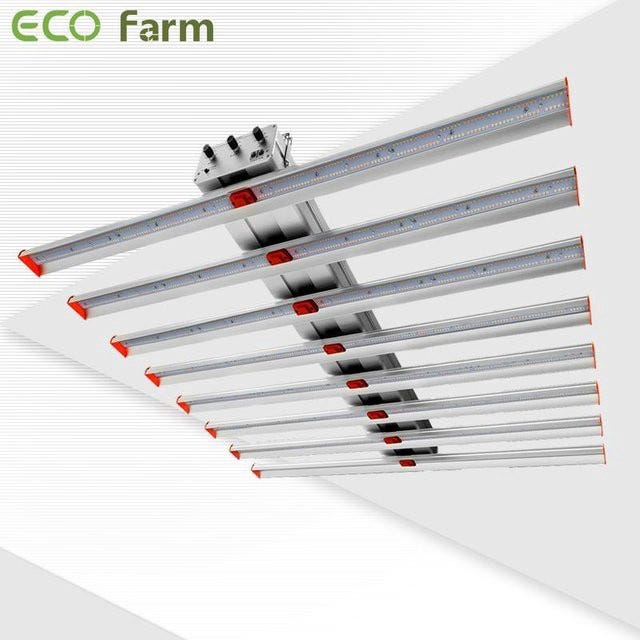
Features:
The ECO Farm LED Grow Light delivers growers and indoor gardeners the ability to stimulate pre-visibility, boost yields and increase quality all season long. The grow light utilizes uses the best parts, Top Bin Samsung LM301H & Os-ram chips, and brand drivers, To achieve higher efficiency and longer service life; The light intensity is higher, the light attenuation is smaller, and the lumen and PAR value are better than ordinary LED. It enables you to obtain a 30% higher output than HPS. The number of ECOZ PRO 1000W chips is 3480PCS. ECOZ PRO industry’s top light efficiency -2.9 μmol/j; This durably constructed LED grow light delivers smooth, even light over the canopy. This kind of growth lamp is a full-period lighting solution suitable for all growth environments (including humid environments), and is an ideal choice for greenhouse or indoor lighting.
ChilLED Growcraft X6–1000 Watt DIY Kit
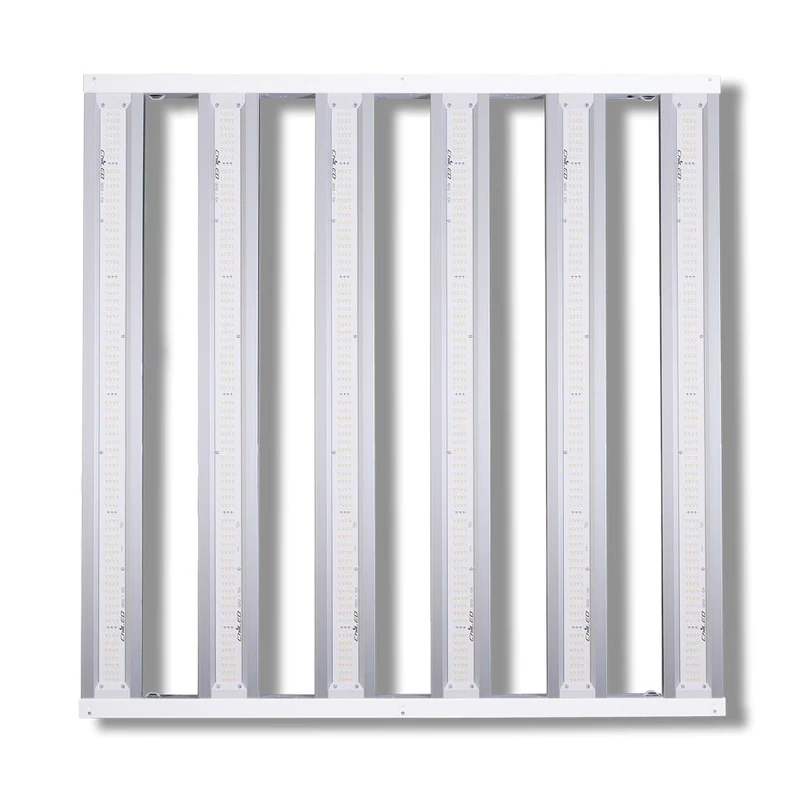
Features:
ChilLED LED Grow Light is designed to give you the best yield possible. This high-performance light has a large footprint, easily adapts to any environment, and can be adjusted from 5% to 100% brightness to reduce operating costs, making it the perfect replacement for traditional HPS bulbs. The passive cooling design of the X6 has no moving parts, so the system dissipates heat slowly and with minimal noise. With the included dimmer, you can adjust the light intensity according to the growth stage of your plants while reducing operating costs. X6 is designed to support all growth stages of the plant life cycle. The LEDs of this premium grow light emit a full spectrum, giving your indoor plants a welcome boost. ChilLED X6 1000 Watt LED Grow Lights outperform regular HPS bulbs without breaking a sweat. It has increased plant output and profits by 70% without increasing operating costs, heat, energy costs and cooling expenses.
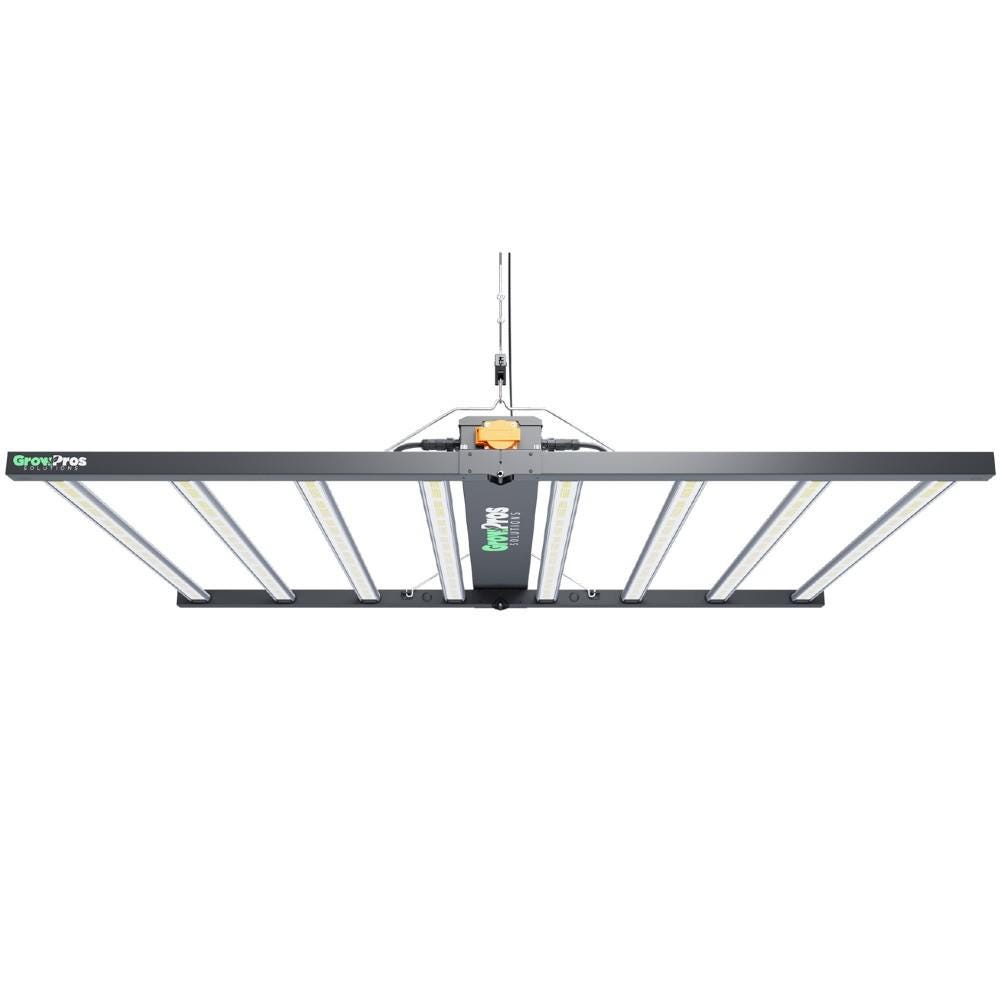
Features:
The GrowPros LED grow light, with a longer lifespan than traditional grow light sources, produces healthier, happier plants. The grow light yields 1.8 grams of crop per watt (dry). High PPFD and PAR indicate high efficiency, or light output per unit of power consumption. Compared to traditional HID and HPS light sources, the HM960 saves about 50% energy, and you can save a lot of energy over time. Almost 100% of energy consumption is converted into light energy for growth. The HM960 lighting system is a complete pre-assembled LED grow light that reduces installation time with a variety of wiring techniques and connectors. This grow light systems run cooler with passive cooling thermal management, meaning your lighting system will last longer while maintaining high light output levels.
What to Look for in Indoor Grow Lights
When growing plants indoors, it is crucial to choose a grow light that emits the correct wavelength of light.
Different colors of light help plants grow in different ways. For example, blue light is necessary for plants to grow leaves and stems. Red light helps plants to flower and bear fruit.
UV (ultraviolet) and IR (infrared) light are also beneficial to plants. Infrared enhances the stems of plants. UV light is important to plants because it helps them produce essential oils and other beneficial substances. Without UV rays, plants lose their health benefits.
Full-spectrum grow lights not only emit all the wavelengths plants need, but they are also the best type of grow lights. Although full-spectrum grow lights cost more than other types of grow lights, they produce higher yields, making them worth the investment.
In addition to the type of light, there are a few other characteristics to look out for when choosing grow lights for herbaceous plants.
The first is light intensity. Plants need a lot of light, so it’s important to choose grow lights that are powerful enough to meet their needs.
The second is the duration of the light. Plants love sunlight and need about 6–8 hours of light per day. If you use grow lights, you need to make sure it is on for at least 6 hours a day.
The third is the setup and size of the garden. Are you planning to have a large garden, or are you planning to grow a few of your favorite plants? The size and layout of your garden will determine which grow lights best suit your needs.
If you have a large indoor garden, you will need to purchase or build a grow lighting system large enough to meet the needs of the plants.
Also, where will you put the grow lights? You need to make sure the plants are in the light range where they can get their full benefit. Do you want your grow lights to stay still or move your plants around? These are important considerations to keep in mind when choosing grow lights for plants.
In addition to the quality of plant lights, another consideration is price. They can be expensive, so it’s best to choose one that fits your budget. You can easily find affordable options as there are many different types of grow lights on the market.
If you are looking for the best LED grow lights, be sure to consider these key factors when purchasing. With the right grow lights, you can enjoy healthy, thriving indoor plants year-round.
Conclusion
Lighting is the most important factor affecting the growth of indoor plants and the first thing to check for plant decline. This is especially noticeable in winter, when houses get less light. Choosing grow lights for your houseplants may seem daunting, but it doesn’t have to be; there are plenty of great options out here.
3 Best Professional 1000W LED Grow Lights of 2023
November 18, 2022
The LEDs you choose will be a huge part of your garden’s success, so choosing the right ones is very important. Even if you know everything about LED grow lights now, finding the right one at the right price can still be tricky. So when it comes to shopping for the best LED grow lights for your grow room or grow tent, check out the best bang for your buck options. We’ll be happy to help you choose the LED grow light that best suits your needs.
What lights do professional growers use?
The lights most widely used for growing vegetables and flowers are metal halide HID and high pressure sodium (HPS). However, LEDs are now replacing both types of lamps because they are highly efficient and economical.
Any full-spectrum light should be a good choice for growing plants. This is because they provide all the light the plants need to grow adequately.
What is the best wattage for LED grow lights?
The amount of wattage required to grow plants varies from plant to plant. For example, plants that require a lot of light, such as tomatoes, need about 40 watts per square foot to thrive.
For plants that require low light and small leaves, like lettuce, you may only need 20–30 watts per square foot.
Also, the wattage of different LED grow lights will determine how many plants can be used under them. For example, with a 1000-watt LED light, up to Twenty plants can be grown.
ECO Farm ECOZ 1000W Samsung 301H Chips LED Grow Light With Separately UV+IR Control
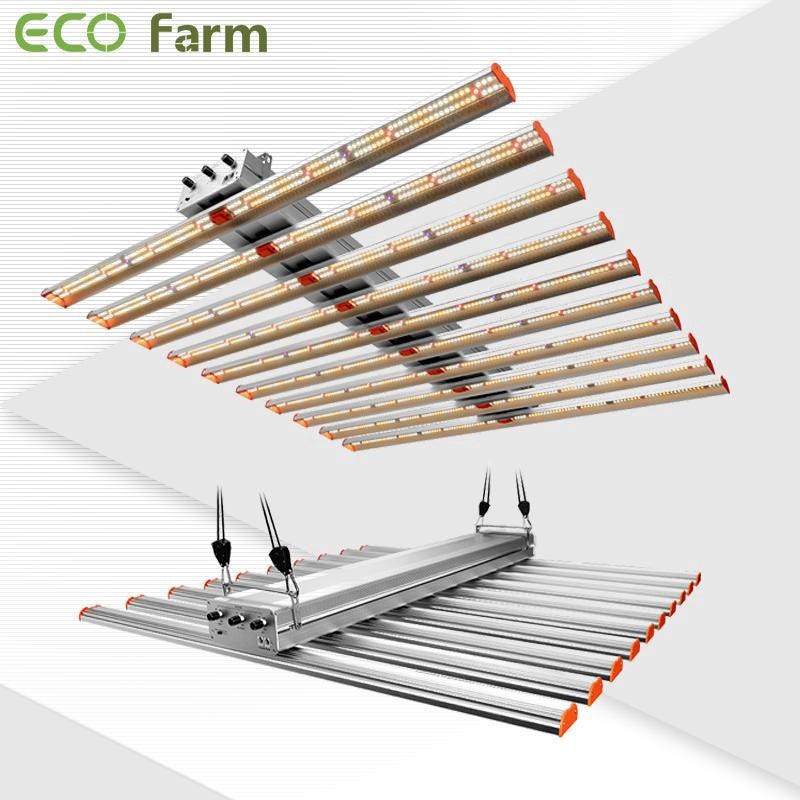
Features:
The ECO Farm grow light is equipped with Top Bing Samsung & Osram Chip and brand driver to ensure high-efficiency PPE 2.9umol/J, better heat dissipation, and long service life. Compared with old plant lights, the average PPFD is increased by 30 %, and the yield and quality are increased by 50%. At the same time, it also has the most trustworthy full Cycle Sunlike Spectrum, close to natural sunlight. The spectrum applies to the entire stage of indoor planting. This ECO Farm LED grow light has independent control of the VEG switch, Bloom switch, and UV switch. VEG dimmer controls white light 5000K, one Bloom dimming The device controls white light + red light (3000K+660nm+730nm), and the UV dimmer controls UV 395nm. And there are optional knobs and touch screen controllers.
Spectrum King Phoenix 1050W LED Grow Light
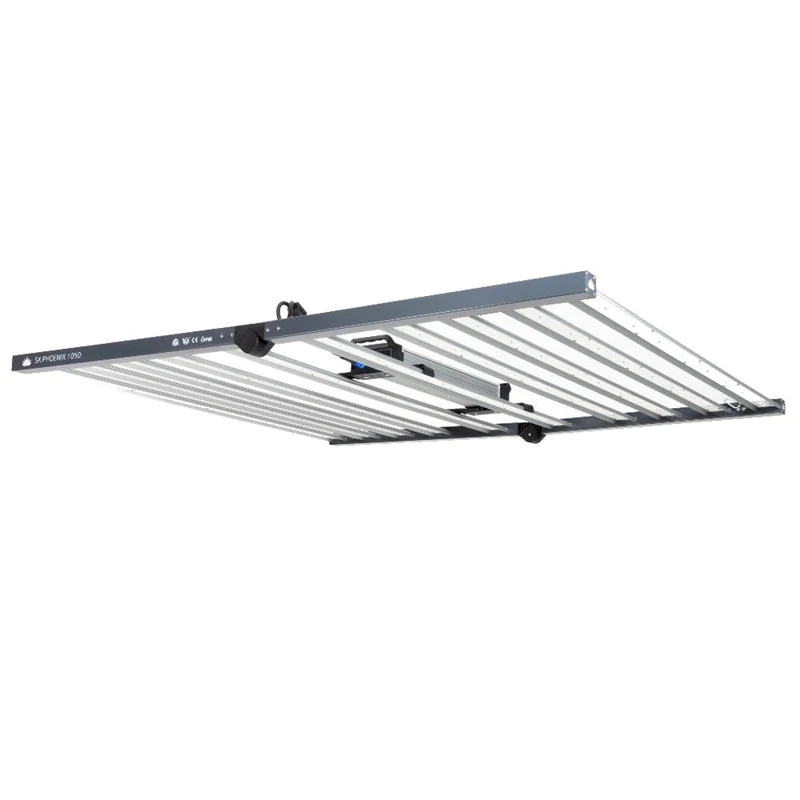
Features:
Spectrum King’s Phoenix 1050W LED Grow Light is a grow lighting beast that unleashes 1050 watts of sun-like light in areas up to 6' x 6', unleashing the ultimate output for your grows. Designed to hang high, the Phoenix 1050 recreates the sunniest summer days for plants that never seem to get enough light. SK Cryo-Therm cooling technology enables an ultra-thin profile that allows maximum airflow and minimizes microclimates. Optimized for single or multi-tier planting near the canopy. For growers who need the biggest, brightest LEDs, the Phoenix 1050W is for you.
Mars Hydro FC-E1000 Bridgelux 1000W LED Grow Light
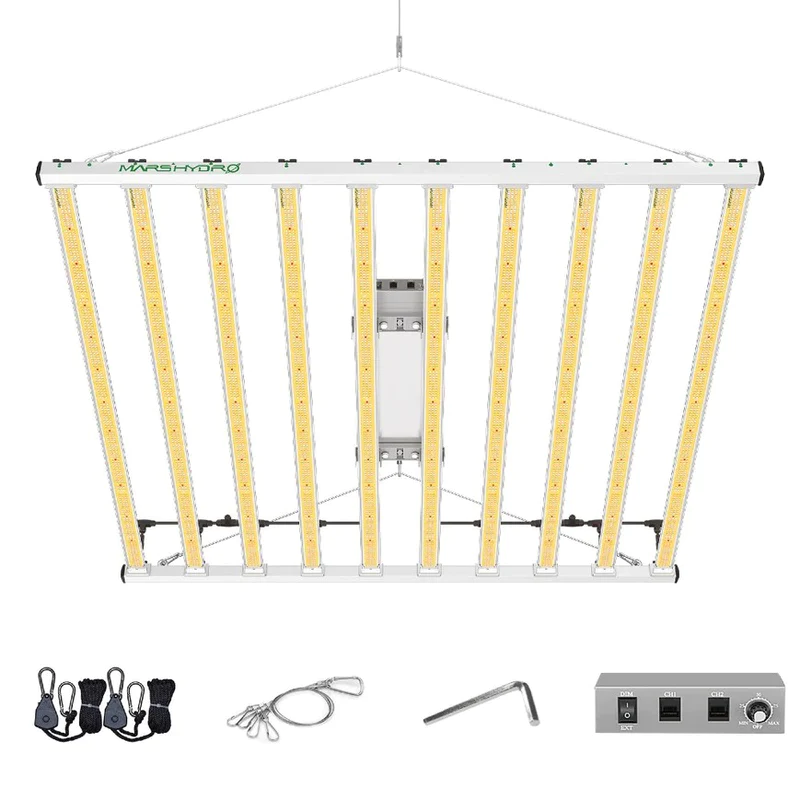
Features:
The Mars Hydro FC-E1000 Bridgelux 1000W LED Grow Light has a full spectrum for full cycle plant growth. FC-E1000W is specially designed for high PPFD culture (such as high concentration CO2 growth). It is by far the most powerful grow light with a high PPF of 2,766 umol/s and an average PPFD of over 1,300 umol/m2/s. The FC-E1000W is slightly different from other FC-E LEDs because of its scalable flexibility, allowing for customization and configuration. Typically, 10 light bars are arranged on 2 support bars to provide an unusually high amount of power for an area of 4x4 feet.
Factors To Consider When Choosing A LED Grow Light
There are a couple of factors you need to put into consideration before choosing a LED to grow light. There are lots of advantages to getting LED to grow light and compared to incandescent lamps, they are energy efficient and emit less heat too. LED grow lights are available in different sizes, intensities, colors to suit your plants.
So to make sure you are choosing the right one for your indoor plants, here are factors to consider.
1. Power Consumption
Since LED lights are designed to emit less heat then you need to make sure they are energy efficient. Although they are made to consume less energy but high-power LED lights should be chosen carefully. But typically you should expect energy savings to the tune of 25% to 30 %.
2. Light Spectrum
The colors produced by the LED grow light plays an important role in the growth of your indoor plants. LED grow light needs to be user-friendly and not so bright that it hurts your eye. Ensure you are choosing one with quality light and easy-to-operate features.
3. Duration
How long the light is going to last is also another very important factor. It is important to go for one that can provide your plants with light for a period of 24 hours and also ensure it can be controlled. A programmable timer should come with it so you can easily turn the lights on and off.
Conclusion
The best LED grow lights are the ones that provide just the right amount of light for plants to bloom. The light should be bright enough to encourage flowering, but not so bright that it wilts. The lights should also be adjustable so that they can be dimmed when the plants are not actively blooming.
Best 1000 Watt LED Grow Lights - Top 3 Grow Lights in 2023
November 16, 2022
1000W LED grow lights are becoming more and more popular in all kinds of indoor gardening. The best 1000W LED grow lights can help you grow strong, healthy plants. They can give you huge yields and good quality fruit and flowers. Growing indoors has many advantages.
What are the advantages of 1000W LED grow lights?
1000 Watt LED Grow Lights offer many advantages over traditional HID or low wattage LED grow systems. Below, we briefly discuss the advantages of using 1,000W LED grow lights when growing plants.
One lamp does everything
The most exciting aspect of the 1000 Watt LED Grow Light is that it can be used in all growth stages.
From germination to late flowering, the 1,000-watt LED system is a jack-of-all-trades for indoor growing. Growers can utilize dimmer switches or raise the height of the system to suit the growing stage of the crop.
The most exciting aspect of the 1000 Watt LED Grow Light is that it can be used in all growth stages.
Future-proof indoor gardens
Building on the previous point — buying a 1000W LED grow light will prove your indoor garden for years to come.
Whether you decide to continue growing in the 5'x5' grow tent or upgrade to a 10'x10' — 1,000 watt LED system is flexible.
Big watts = Big buds
That’s right, the more PAR-rich lumens you put on your crop — the bigger the buds.
With its huge PAR values and generous lumen output, the 1000W LED Grow Light is a must-have for any grower looking to break personal yield records.
The more PAR-rich lumens you put on your crop, the bigger the buds will be.
Reduce your electricity bill
Since a 1,000-watt LED grow light consumes 1,000 watts of electricity — it’s safe to say you won’t be saving money on the lights themselves.
However, 1000W LED grow lights are more efficient than HIDs and emit much less heat. So, by reducing the need for your HVAC system, you’ll save a ton of money on your electricity bills.
ECO Farm ECOZ 1000W Samsung 301H Chips LED Grow Light With Separately UV+IR Control
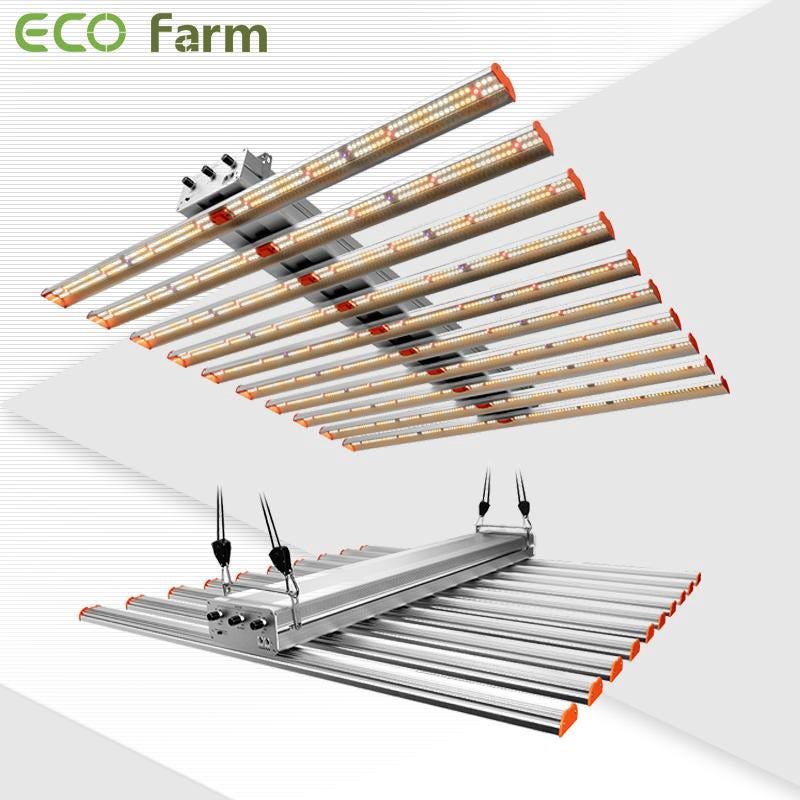
Features:
The ECO Farm grow light is equipped with Top Bing Samsung & Osram Chip and brand driver to ensure high-efficiency PPE 2.9umol/J, better heat dissipation, and long service life. Compared with old plant lights, the average PPFD is increased by 30 %, and the yield and quality are increased by 50%. At the same time, it also has the most trustworthy full Cycle Sunlike Spectrum, close to natural sunlight. The spectrum applies to the entire stage of indoor planting. This ECO Farm LED grow light has independent control of the VEG switch, Bloom switch, and UV switch. VEG dimmer controls white light 5000K, one Bloom dimming The device controls white light + red light (3000K+660nm+730nm), and the UV dimmer controls UV 395nm. And there are optional knobs and touch screen controllers.
Spider Farmer SE1000W Dimmable Full Spectrum CO2 LED Grow Light
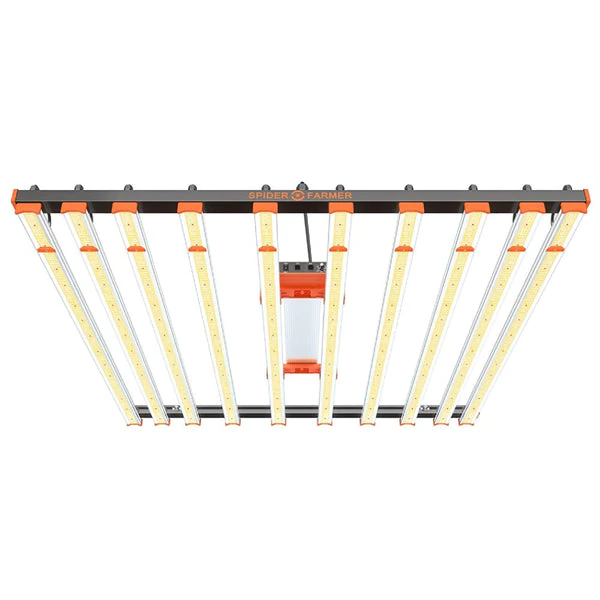
Features:
Spider Farmer LED Grow Lights feature a uniquely designed extension of 10 to provide more even and complete canopy coverage, especially in exterior growing areas. With 3710 SAMSUNG LM301B diodes, the SE1000W Led Grow Light consumes 1000 watts at 2955 umol/s, achieving an impressive PPE of 2.9 umol/J, covering a high yield full cycle growth of 4'x4'. The dimmer knob is ideal for growers to adjust light intensity for different growth stages. The SE1000W grow light comes with a detachable driver and long power cord to reduce ambient heat in the grow space and extend its lifespan. The LED diodes are coated with water repellent, so there is no need to worry about wet environment.
Mars Hydro FC-E1000 Bridgelux 1000W LED Grow Light

Features:
The Mars Hydro FC-E1000 Bridgelux 1000W LED Grow Light has a full spectrum for full cycle plant growth. FC-E1000W is specially designed for high PPFD culture (such as high concentration CO2 growth). It is by far the most powerful grow light with a high PPF of 2,766 umol/s and an average PPFD of over 1,300 umol/m2/s. The FC-E1000W is slightly different from other FC-E LEDs because of its scalable flexibility, allowing for customization and configuration. Typically, 10 light bars are arranged on 2 support bars to provide an unusually high amount of power for an area of 4x4 feet.
What Makes a Quality LED Grow Light?
Here are some important things you should look for in a quality LED grow light:
1. Full spectrum (including IR and UV)
Full Spectrum LED Grow Lights will provide your plants with the various wavelengths of light they need to maximize their growth (higher yield).
Most manufacturers provide details or diagrams about their spectral output. Look for blue light between 430nm-450nm during the vegetation stage and red light between 640nm-680nm during the flowering stage.
You should also look for LED grow lights that contain UV (ultraviolet) and IR (infrared) diodes.
UV rays have been shown to make your plants mount a defensive response and produce more trichomes. This results in increased THC levels (higher potency)
The benefits of infrared are more debated, but many experts believe it promotes larger leaf growth and increases yield.
2. High PAR output
PAR (measured in umol/2/s) is the spectrum plants use for photosynthesis, so you need to feed them a lot.
Most good manufacturers will provide you with a graph showing your plants’ PAR values at different heights.
Between 200–400 umols is great for seedlings. 400–600 umols is the optimal amount for later plant growth cycle and 700–900 umols is the optimal amount for flowering.
3. Daisy chain function
This is a very useful feature if you need to purchase multiple lights.
This feature allows you to plug one light into another so you only need one power cord.
This makes it easier to hang lights side by side, keeps your planting space organized, and frees up socket space.
4. Veg & Bloom switch
The Veg & Bloom switch allows you to optimize light intensity for different stages of the growing cycle.
This prevents your seedlings from minor burns and saves you money on electricity bills.
5. Good warranty
Make sure to choose grow lights with a 2–3 year warranty.
The LEDs should last 10+ years, but having a good warranty gives you peace of mind that if anything goes wrong, you’ll get a replacement or your money back
Conclusion
When it comes to grow lights, there are several factors you should consider before purchasing new lights.
The size of the light fixture and the area you plan to grow your plants in will affect how large you need it.
Consider the amount of space and headroom above the plants.
If possible, hang the lights higher than the plants. If you can’t find lights high enough, consider keeping them low to avoid obstructing them.
The LED lights are bright enough for demanding growers and are available in white or red/purple. LED grow lights are inexpensive, so you might want to consider getting one of these.
How to Choose the Best 1000W LED Grow Lights for Indoor Plants (Beginner's Guide)
November 14, 2022
Gardening under LED grow lights is a popular and effective way to grow indoor plants. When using LED grow lights, it is important to choose full spectrum LED grow lights to maximize plant growth.
Full-spectrum LED grow lights provide the full-spectrum light plants need for photosynthesis. These lights can be used to grow plants from seedlings to mature. They are also ideal for growing plants that require high light, such as tomatoes and peppers.
LED grow lights are available in a variety of sizes, shapes and wattages. They can be used with hydroponic systems, soil systems, or combined with other grow lights.
What Grow Light Setting is Best for Seedlings?
When it comes to growing lights, there are basically 3 different settings that can be used for seedlings. But which one is the best? Let’s take a closer look.
Full spectrum
The first setting is called the “full spectrum”. This means that the light emitted from the grow light covers all of the colors in the visible light spectrum. This is beneficial because it provides your seedlings with the full range of light that they need for healthy growth.
Partial spectrum
The second setting is called the “partial spectrum”. This means that the light emitted from the grow light does not cover all of the colors in the visible light spectrum. Instead, it focuses on a specific range of colors. This can be beneficial if you are trying to encourage certain types of growth in your seedlings such as more compact growth or increased flowering.
Monochromatic
The third and final setting is called “monochromatic”. This means that only a single color of light is emitted from the grow light. While this may seem like it would be bad for your seedlings, monochromatic light can actually be quite beneficial for certain types of plants. For example, blue light is known to promote compact growth in plants, while red light can help to increase flowering. So, which grow light setting should you use for your seedlings?
Ultimately, it depends on what type of growth you are trying to encourage and what your specific goals are. If you’re not sure, starting with a full spectrum grow light is always a good idea. From there, you can experiment with partial or monochromatic settings to see what works best for your plants.
ECO Farm ECOZ 1000W Samsung 301H Chips LED Grow Light With Separately UV+IR Control

Features:
The ECO Farm grow light is equipped with Top Bing Samsung & Osram Chip and brand driver to ensure high-efficiency PPE 2.9umol/J, better heat dissipation, and long service life. Compared with old plant lights, the average PPFD is increased by 30 %, and the yield and quality are increased by 50%. At the same time, it also has the most trustworthy full Cycle Sunlike Spectrum, close to natural sunlight. The spectrum applies to the entire stage of indoor planting. This ECO Farm LED grow light has independent control of the VEG switch, Bloom switch, and UV switch. VEG dimmer controls white light 5000K, one Bloom dimming The device controls white light + red light (3000K+660nm+730nm), and the UV dimmer controls UV 395nm. And there are optional knobs and touch screen controllers.
Spider Farmer SE1000W Dimmable Full Spectrum CO2 LED Grow Light

Features:
Spider Farmer LED Grow Lights feature a uniquely designed extension of 10 to provide more even and complete canopy coverage, especially in exterior growing areas. With 3710 SAMSUNG LM301B diodes, the SE1000W Led Grow Light consumes 1000 watts at 2955 umol/s, achieving an impressive PPE of 2.9 umol/J, covering a high yield full cycle growth of 4'x4'. The dimmer knob is ideal for growers to adjust light intensity for different growth stages. The SE1000W grow light comes with a detachable driver and long power cord to reduce ambient heat in the grow space and extend its lifespan. The LED diodes are coated with water repellent, so there is no need to worry about wet environment.
GrowPros HM960 LED Grow Light For Indoor Plants
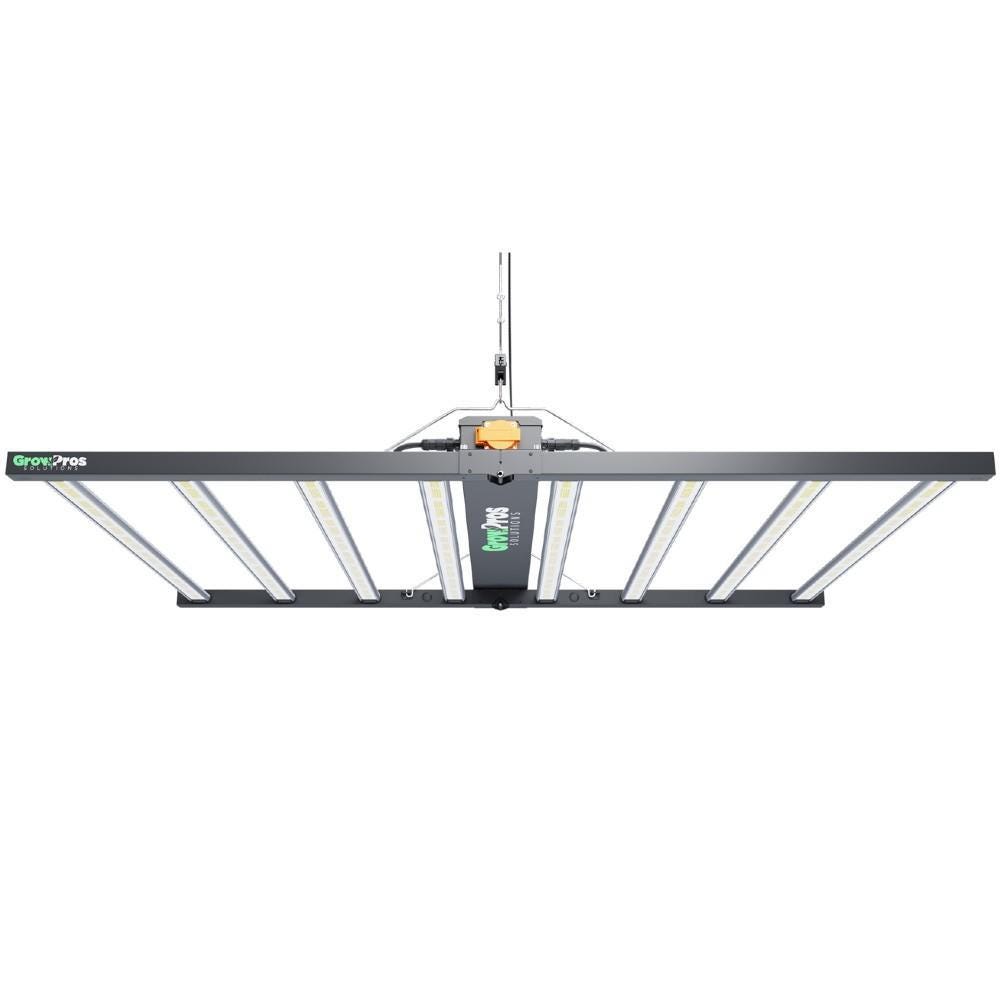
Features:
The GrowPros grow light produces 1.8 gram per watts (dried) of crop yield. Generating about 50% more in energy savings over traditional HID and HPS light sources, the HM960 gives you meaningful savings over time. Will not produce the same results without CO2 supplementation. The HM960 Series system runs cool thanks to a passive cooling thermal management system, meaning your lighting systems last longer while retaining high light output levels. A longer lifespan means you can grow crops for many years without needing to replace the lighting system, reducing costs. Indoor plants grow best under full-spectrum lights, which replicate the natural spectrum of the sun. The HM960 Series, with an increased lifespan over traditional, grow light sources, cultivates healthier, happier plants.
How Do Colored Lights Affect Plant Growth?
It’s the time to understand what role each of them plays, we’ll see exactly how colored lights affect plant growth by talking about the two most important lights for plants.
Red Light
Red wavelengths initiate seed germination and root development.
Fluorescent lights produce the red wavelengths, which is why they can be used for growing microgreens indoors.
Let’s state the important: red light is the most efficient for photosynthesis and basically nothing can be done without the red light.
Moreover, red light helps the flowering and fruiting stages and it also prolongs flowering.
Does that make it the answer to what color light is best for plant growth?
The simple answer is no. The truth is that having only red light would result in poor growth. A result could be plants with elongated stems.
Blue Light
So, blue is added to the red in order to maintain the proper shape of plants, to make them grow compact.
Blue light is required for plant growth.
Bluelight photoreceptors influence chlorophyll production and regulate a plant’s retention of water.
We can’t only use blue light either because plants’ growth will be negatively affected.
Which is why there must a combination of blue and red, LED manufacturers offering a fixed ratio of red to blue for greenhouses.
If we were to ask is red or blue light better for plants, the answer would be that there must always be a combination of red and blue for productive plant growth.
So, another answer to what color light is best for plant growth would be: red and blue. Or white light if you choose full-spectrum LEDs.
Yellow and green lights have minimal effect.
White Light
This is a combination of red, blue, and green. It’s the best and it’s the version that comes closest to sunlight. That’s why white light should be our choice for growing plants indoors and even in greenhouses.
White light is also known as full-spectrum. We can get full-spectrum LEDs but we can also get full-spectrum T5 lamps.
By varying the intensities of the individual red, blue and green chips, we get white light.
Full-spectrum growth lights can result in better growth and improve yields over the traditional red/blue lights.
Red/blue lights give off a pink/purple hue and are also known as narrow spectrum. We can use them in greenhouses where the plants are already receiving the full spectrum from the sun.
Warm white vs cool white
Warm has more red and cool has more blue.
That means that we go for warm if we want to flower the plants and help them fruit. Cool white works best for seedlings, microgreens, leafy greens, herbs, etc.
Are Full-Spectrum LED Grow Lights the Best for Plant Growth?
The simplest answer to give if you’re wondering how do colored lights affect plant growth is: go for full-spectrum LED grow lights or go for red/blue spectrum LEDs.
LED stands for light-emitting diode. Their main advantage is that they offer more light with less power consumption. It makes them very efficient and enable us to save on energy costs. Their longevity of 25,000 to 30,000 hours is their second biggest advantage.
Choosing to get full spectrum LED grow lights is the best general solution to growing plants indoors by using just artificial light.
I used the word mimic because the artificial light doesn’t in fact come close to natural sunlight. It’s not surprising considering that sunlight is complex, it’s not only a matter of producing a Color Rendering Index (CRI) over 90.
Full-spectrum LED grow lights are the obvious choice when it comes to answering what color light is best for plant growth because these are the ones that mimic the natural light from the sun.
The second option is to go for red/blue spectrum LEDs but that’s recommended mainly for greenhouse, spaces which already receive a certain amount of sunlight.
Well,
Not all full-spectrum LED grow lights are created equal because not all of them are custom-tailored for rigorous plant growth.
From that, we can draw our own conclusion: we should pay attention when shopping and choose LED grow lights that have been designed for plant growth. Most are not cheap.
Conclusion
In short, LED plant growth lights are the future development direction. They are more energy efficient, last longer, and don’t emit as much heat. This is important for those who grow plants indoors. LEDs will help you save on your electricity bills, and those savings will offset the extra money you pay for LED grow lights.
LEDs are also a great way to save energy, as they use up to 75% less electricity than traditional grow lights like HPS lights. The only downside to LEDs is that they aren’t as bright as other types of lighting, so when you’re working in the garden at night or on an overcast day with low light, you won’t be able to see (but this is easily done by getting some extra high intensity light to solve).
3 Best Cheap LED Grow Lights For Best Yields - 2022 Review
November 11, 2022
Are you looking for the best LED grow lights?
Your search is complete here…
We’ve found high-quality grow lights that can help you grow quality and healthy plants…
So, here’s our list of the best LED grow lights for the indoor plants and flowers.
How Lighting is Measured
Before going through the various types of artificial light, it is good to see how light is measured, and what each bulb has to offer.
There are a few ways that light is measured, but some are almost obsolete, but still used in some things. Foot-candles or candle power is one such term, and this often relates to flashlights or spotlights that shine in millions or thousands of candle power.
Temperature is one of the primary terms you will see when growing indoors and looking for the ideal light. This temperature has nothing to do with heat output, but it is a reference to the natural color of the light produced.
When we see cool lights, these deliver light at the blue end of the spectrum (also called blue light) while when we look at lights that are warmly looking, these are providing light at the orange/ red end of the spectrum.
Lights can be measured by watt power, nanometers (nm), or Lumens most often. The watt power (or wattage) is the unit of energy required to run the lighting, and it is the term most people are familiar with. When it comes to growing lights, these are often rated to the number of watts needed for each centimeter squared of the surface to be illuminated.
Lumens is a reflection of how bright an LED grow light is, and although used, these lumens are not actually a rating that does anything for the plants. The light required by plants is beyond the physically visible spectrum.
When light is measured in nanometers, this is actually the light we can see. This visible light falls in the range of 400 to 700 nm. When you compare this to the color spectrum, the warm or red end will be reading 730 nm, and at the other end in the color part of the spectrum (violet), this will be reading 400 nm.
Almost all indoor grow lights fall in the range of 450 nm to 730 nm. These are the most crucial nm measures with one addition of 650 nm in the middle of the spectrum.
We all know that plants need to photosynthesize, and for plants to do this, there is the need for light at the 450 nm and 650 nm levels. With these, plants can create the food it requires from the light available along with water and carbon dioxide. It is the green pigment where chlorophyll is produced.
When plants use the 650 nm and 730 nm ranges, this allows them to control their flowering through another pigment which is called phytochrome.
This is why the full spectrum of light is required at varying stages of a plant’s growth, and this is why it is crucial to have the best grow lights that allow growers to replicate the light provided by the sun in an outdoor garden.
ECO Farm SP-600 Samsung Foldable Dimmable Full Spectrum LED Grow Light
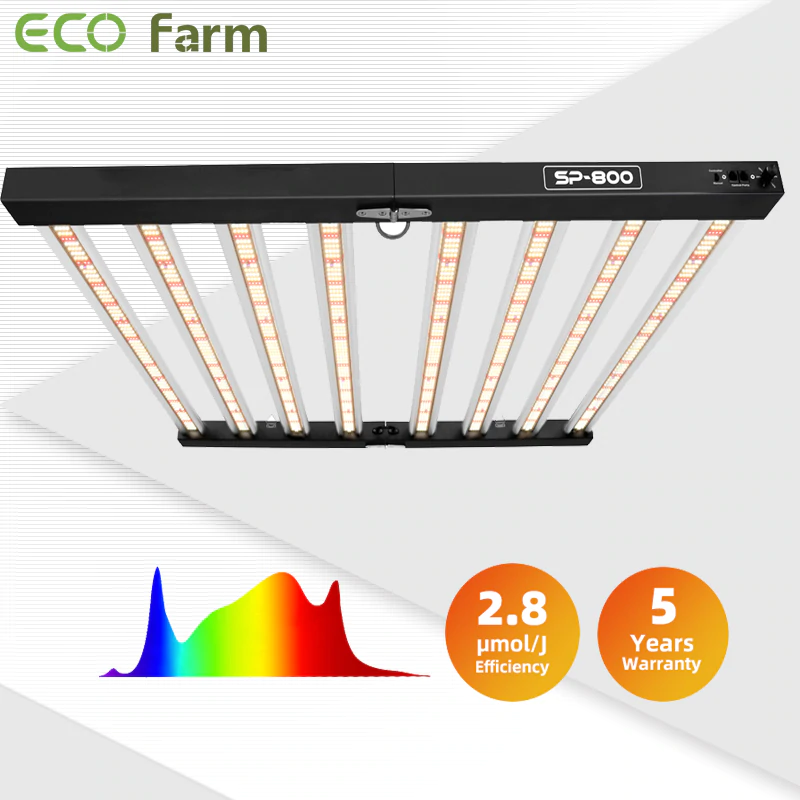
Features:
With a high efficiency of 2.8 umol/j and a power consumption of 630W, this ECO Farm LED grow light facilitates efficient growing operations, helping you efficiently optimize plant growth, improve yield quality and reduce operating costs. This full spectrum LED grow light promotes photosynthesis at all stages of growth, especially flowering, from cutting/seeding, nutrition and flowering. Grow lights for indoor plants replicate the spectrum of natural sunlight and output a broad, consistent and pronounced wavelength range from 400 to 700nm that can be grown throughout the plant life cycle. It can help your plants grow healthier and have better harvests. LEDs generate far less heat than HPS and other HID lights, making them ideal for gardening. The aluminum heatsink, along with the wide 6 passive cooling strips, better removes heat to keep you cool and reduces ambient heat in the grow space for longer lamp life.
Spectrum King 600W LED LowPro Flower
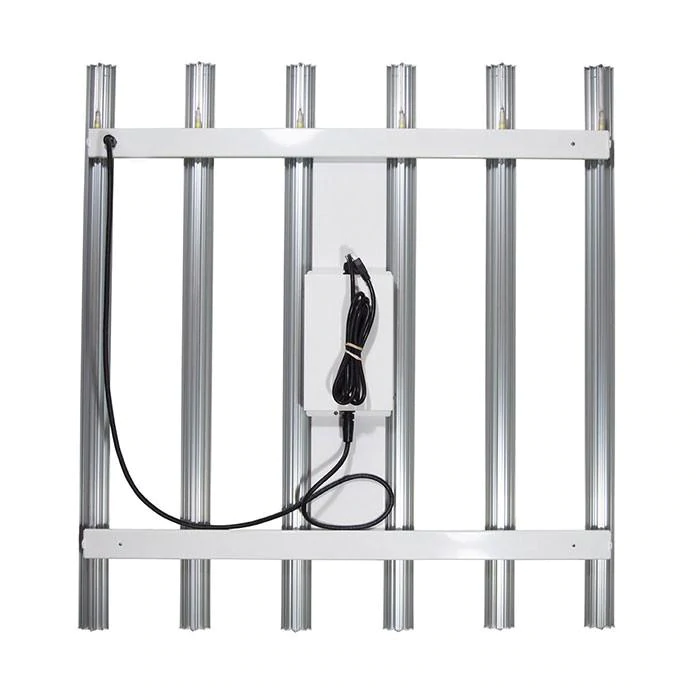
Features:
The Spectrum King LED grow light is a 660W grow light system with an efficiency equivalent to a 1000W LED. The grow light system is designed for vertical shelving solutions; you mount the lights 3 inches from the plants. Grow lights offer a 4X4 footprint. It offers 141.57 efficacy and a lumen output of 102,000 lumens. LED grow lights feel like plants are getting closer to the sun. The planting system is designed for a 3" tall vertical racking solution. The LED grow light system is the shortest and brightest LED grow light system on the market. The LEDs are rated at 50,000 hours to ensure long life. So don’t worry about spending unnecessarily on grow light fixtures.
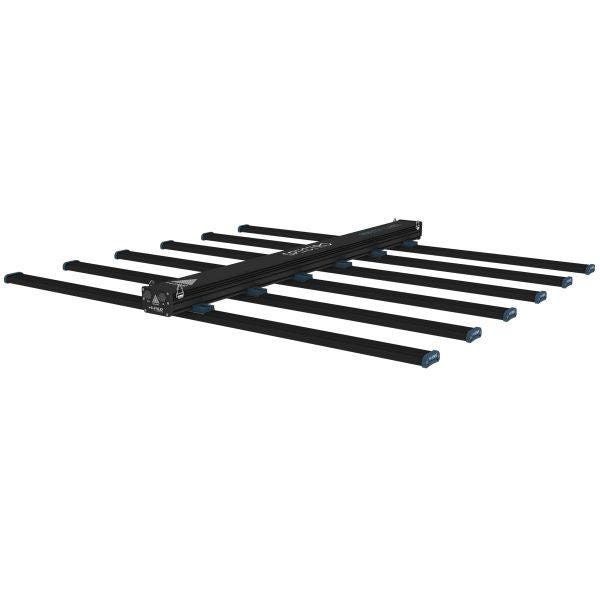
Features:
The HI-PAR LED Grow Light is an innovative true full-spectrum LED fixture, with a futuristic design unlike anything else; the HI-PAR 660w LED Spectro delivers maximum performance and efficiency with removable LED bars for customization while maintaining the highest possible output and huge coverage. SPECTRO 660w LED is built tough for durability and is compatible with the HI-PAR Control Station V2. Utilizing a unique and innovative design, the Hi-Par Spectro LED 660W delivers maximum power and efficiency to guarantee amazing results.
What Factors Should You Consider When Buying LED Grow Lights?
Having a wide array of LED grow light models from different manufacturers is a welcomed development. It means growers have a lot of options to choose from. However, it also makes it tricky to make the right choice. This section outlines the important factors, and features you should look out for when shopping for your next set of LED grow lights.
1. Price
The truth is the quality of LED grow lights you can get depends on how much money you have to spend. While these devices are not exactly cheap, growers should set a realistic budget and work with the same while shopping. The goal here is to get lights that offer the best value for their price. A good LED grow light may cost between less than 100 USD and up to 1,000 USD, depending on the specifications. For example, a full spectrum LED grow light will cost more than models without UV lighting. Other factors like the diode brand, light intensity, and warranty length may also contribute to the overall cost of any grow light model. However, you will most likely find cost-effective options that fall within that price range irrespective of what you are looking for.
2. Light Intensity
Light intensity simply means the amount of power you get from a grow light. Growers tend to assess the light intensity of a grow light by its wattage. But this is not entirely accurate. Other specifications like the Photosynthetic Photon Flux Density (PPFD), Photosynthetic Photon Flux (PPF), and efficacy all contribute to the overall light intensity a LED grow light delivers. The Photosynthetic Photon Flux (PPF) of a grow light is the amount of light it produces per second and is measured in umol/s. It is the official unmanipulated measurement of the full amount of light any LED grow light can produce. The Photosynthetic Photon Flux Density (PPFD) is slightly different. It estimates the number of photons that reaches a square meter of the grow area per second. Measured in umol/m2/s, this metric shows how well the plants use the photons from the light source. Various plant types have their own recommended PPFD. It is best to go for grow lights that efficiently and equally distribute light across the grow area. The last contributory factor — efficacy — describes how many photons you derive on the same power consumption.
3. Spectrum
The spectrum is another essential factor to watch out for when you want to buy grow lights. Not all LED grow lights are full spectrum, but it is best to go for full spectrum models. Full-spectrum light comprises five different sections — the UV light, blue light, visible PAR light, red light, and the far-red light. Having all wavelengths of light means a single full spectrum LED grow light can contribute to all the stages and aspects of plant growth. In addition to their efficiency, adopting full spectrum LED grow light makes the plant appear more natural, making it easier to discover and monitor plant diseases and pests. The higher amount of green light in a full spectrum grow light translates to higher PPFD, which is great for light-hungry medical plants. That way, they can absorb more green light and increase yield.
4. Coverage Area
Knowing the precise dimensions of your growing space before shopping for a LED grow light is important. For example, hobbyist growers grow in 5 square meters or smaller areas, while commercial growers can go several hundred square meters or even thousands in some cases. The smaller growing areas can rely on less powerful lights. Still, anything larger than 5 square meters will require multiple large, powerful lights to cover all the edges and corners and ensure an even light intensity over the canopy.
Conclusion
Finding the best LED grow lights can be quite a daunting task. LED stands for quality, and quality comes with the misconception that it’s always expensive.
LED grow lights have been successful in producing high yields and high quality results.
So if you’re planning to buy grow lights, don’t forget to check out our list.
The Best 1000W LED Grow Lights for Indoor Plants in 2022 [Reviews]
November 02, 2022
You don’t need a lot of space to grow your own plants, but light is essential. Choosing the best LED grow light is a key factor in providing the right healthy growing environment for your plants. In addition to air, water and nutrients, light quality also has a major impact on plant survival.
Grow lights are not like standard household lights. They fall into two categories: blue/red spectrum or full spectrum. The blue/red (also known as blur) spectrum maximizes photosynthesis to promote overall plant health and is often recommended in greenhouses that already receive a lot of natural light. Full spectrum increases the “white” sunlight component of indoor growth. The full spectrum also has green light, which until recently was not considered particularly important for plant growth. However, research now suggests that it may help during photosynthesis.
LED grow lights — well, generally speaking, LED lights — consume less energy than traditional fluorescent or high-density discharge models, last two to three times longer than non-LED competitors, and can be largely recycled . Suitable for both business and home users, they come in several different models and offer a variety of features. The sheer variety can make choosing the most appropriate model challenging. We’ve reviewed the best LED grow lights for a variety of different purposes.
LED Grow Lights for Indoor Plants Explained
If you’re a beginner, you might wonder why your indoor plants need LED lights. To help you choose the best LED lights, you need to first understand what grow lights are and why indoor plants need them. Indoor LED grow lights are artificial lights that can help stimulate plant growth.
Plants often don’t have enough direct light and can struggle to bloom, hence why LED lights are used.
LED grow lights are handy for any indoor plant that needs direct light. Grow light not only stimulates plant growth, but also allows you to start seedlings indoors, but you do need to be aware of certain equipment, such as a built-in timer, which allows the plant to control the type of light it chooses.
LED grow lights can be quite right, so you’ll want to make sure you have a timer to provide shade when needed.
One of the main benefits of an LED grow light is that it can easily fit into a limited space and still help your plants thrive. LED grow lights also reduce the need for chemical and pesticide treatments to plants, as the grow lights are less susceptible to pests.
ECO Farm ECO Z Lite 1000W LED Grow Light
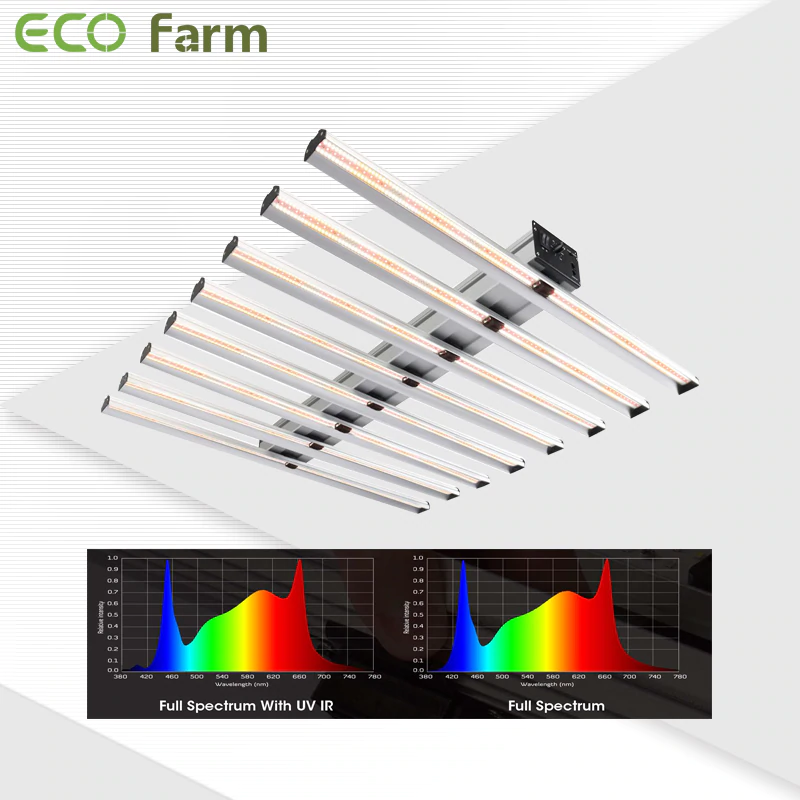
Features:
These ECO Farm LED grow lights ensure concentrated and even lighting and reduce light waste. This plant light brings a 30% increase in output, consumes a total of 1000W, 2800 LEDs, and replaces the traditional 2000W plant light. Achieve higher yields while saving energy costs! Grow lights are easy to assemble yourself in minutes. You can install as many LED strips as you want. Plug and play, effectively save your installation cost and time. The aluminum backplate enables excellent heat dissipation. Pure aluminum light bars better dissipate heat and stay cool, essential for heat dissipation while ensuring long lamp life. No fan, no noise. The cost-effective grow light is designed for home/commercial growers, long-term use of the fan will make noise, but the LED light panel uses aluminum to cool it instead of using a fan, giving you a fanless and quiet growing experience.
PhotonTek XT 1000W CO2 Pro LED
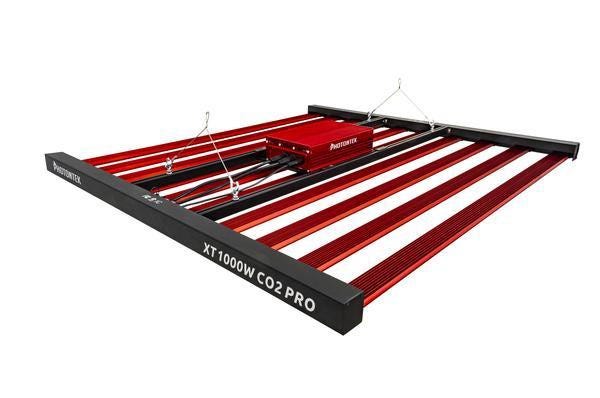
Features:
The PhotonTek LED Grow Light delivers the perfect balance of quality and quantity for brilliantly high quality light combined with ultra-high PPFD levels to help your plants grow healthy and potent. Designed for a 5’x5’ space with use of CO2 supplement for maximum performance, the XT 1000W gives indoor growers and gardeners the ability to give a huge boost to your harvest yields without needing to increase space. The PhotonTek XT 1000W Pro delivers the highest quality light for your plant’s entire growth cycle, making these LEDs the smartest option for healthy, potent harvests a faster return on investment. The XT 1000W CO2 Pro LED is built using high quality and durable PHOTONTEK drivers and top bin LEDs from Osram and Lumileds Philips generating an optimized full-spectrum light source ideal for veg and flowering stages.
GrowPros HM960 LED Grow Light For Indoor Plants

Features:
The GrowPros grow light produces 1.8 gram per watts (dried) of crop yield. Generating about 50% more in energy savings over traditional HID and HPS light sources, the HM960 gives you meaningful savings over time. Will not produce the same results without CO2 supplementation. The HM960 Series system runs cool thanks to a passive cooling thermal management system, meaning your lighting systems last longer while retaining high light output levels. A longer lifespan means you can grow crops for many years without needing to replace the lighting system, reducing costs. Indoor plants grow best under full-spectrum lights, which replicate the natural spectrum of the sun. The HM960 Series, with an increased lifespan over traditional, grow light sources, cultivates healthier, happier plants.
What to look for in grow lights
When it comes to LED grow lights, there are many aspects to consider before deciding on the best option. You have to consider the type of light, the crops you grow and how much light you need, the spectrum, the size of the plantation, and other factors.
Here’s a list of factors you should consider:
Spectrum
Everyone knows that getting the necessary light output is critical for plant growth. But you don’t know that the spectrum they receive is just as important. Plants you grow outdoors grow in natural sunlight, producing every color in the spectrum. Therefore, the best LED grow lights have full spectrum grow lights to stimulate natural sunlight and promote plant growth.
Each wavelength in the spectrum has a different effect on plant growth. Red and blue include the most obvious shades, as blue adds stout to the plant when it is in the vegetative stage.
Once the plants are in the flowering stage, the red light enables them to stretch and bloom. Besides these two, plants also use different colors. For example, plants do not readily absorb green light for photosynthesis, but can penetrate the plant canopy to deliver light to areas with less light saturation.
That’s why full-spectrum LED grow lights must be used. With all the color combinations, it can help with all stages of growth.
Power/Efficiency
When comparing the light output of various plant light fixtures, it’s not just wattage that matters. Wattage indicates how much energy the light consumes, not how much light it gives the plant.
Grow light efficacy, defined as the ability to convert energy into light that crops can use, is the more important consideration. Since efficiency fluctuates depending on the type of light, even fixtures with the same wattage can produce wildly different light output.
When shopping for grow lights, look for those that are efficient so you get the most light for every watt of electricity you pay the power company.
Heat Output
One of the problems when using grow lights is that the heat from the bulbs can harm your plants.
On the other hand, LED lights emit very little heat compared to the amount of light they produce. However, since they generate heat, many versions come with built-in cooling systems to maintain optimal temperature regulation.
Some LED lights include heat sinks made of aluminum, while others have fans. When choosing grow lights, keep in mind that units with fans can be quite noisy.
Desired Light Output (PPF)
The amount of light each plant needs to grow varies. For example, some indoor plant is a very light-consuming plant, requiring more light than vegetables such as tomatoes.
It’s crucial to keep this in mind when choosing the best grow lights for your setup. The PPFD of plants at flowering should be 900–1000 mol/m2/s or higher, but higher is better.
Conclusion
An indoor garden can be a rewarding and fun hobby. Success is easy when you have the right tools at hand. LED lights specially designed for indoor plants make the process a pleasure. There are many systems to choose from and various price points, so there is something for everyone.
3 Best LED Grow Lights For Indoor Plants in 2022
November 01, 2022
Experienced growers know that the success or failure of your cultivation relies on three major factors: Soil, water, and light. No matter what other variables you’re going to tweak, you must get these three elements dialed in if you want to enjoy an abundant harvest.
For the overall cost of your grow, though, choosing the right light can make it all seem worth the time and effort… Or break your wallet and your overall yields. While LED grow lights may not have been a great option even 5 years ago, advances in LED technology have made them our hands-down favorite style of light for consistent, low-maintenance indoor grows!
The only problem with LED grow lights for growing plants? There’s a lot of imitators on the market, trying to sell bargain-bin lights at a premium price. That’s why today, in this review, we’re going to be presenting a comprehensive guide to choosing the right LED grow light for your indoor grow.
With every product taken from a well-vetted source, we’re presenting only the best of the best products from all three styles of LED grow lights. So, what are you waiting for? Let’s get started!
What are grow lights?
Simply put, a grow light is actually an electric light used to help plants grow. Originally, plants would grow naturally due to the Earth’s sun. Photosynthesis requires sunlight. Photosynthesis isn’t just a random word you hear in high school science class — it’s the process plants use to convert light, water, and oxygen into carbohydrates (their source of energy).
Grow lights are usually different from your regular lights; they usually try to mimic sunlight, or they try to provide the ideal light spectrum for certain plants. Some people use different temperatures when growing certain plants to help create the best environment for them.
Mimicking the sun isn’t always a priority, because with a custom grow light setup, you can create an environment that’s better than what’s found in nature.
For example, if your plants can benefit from a lot of sunlight — and a typical day doesn’t provide that — then with grow lights, you can create the most ideal environment for your plants.
So who would find out about using grow lights? various people.
Right now, growing bulbs for houseplants is increasingly used in agriculture. This allows farmers to grow large numbers of plants in a more controlled environment, most of the time free of the specific pests and other hassles they might encounter when growing plants outdoors. Many people find growing plants indoors modern and futuristic appealing, especially due to the benefits of placing them in a controlled and monitored environment free from potentially harmful weather conditions.
While grow bulbs will obviously be highly popular with farmers, many who live in highly urban areas may find it helpful to use grow lights to grow plants indoors. Think of someone who might live in a relatively small apartment in New York City. Basically no backyard for them to grow any plants. Thankfully, many people get the most out of grow lights by keeping their plants inside their cupboards, for example.
ECO Farm ECOT 120W Dimmable Samsung LM301H Quantum board LED Grow Light with UV&IR
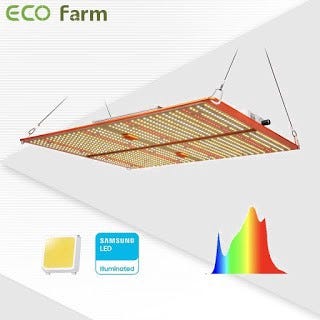
Features:
ECO Farm led grow lights are suitable for all growth stages, with excellent full spectrum-white, blue, red and IR (3000K, 5000K, 660nm and IR 760nm and 395nm UV), especially 660nm red and infrared lights are very useful in bloom, It can increase the growth rate of plants and make the flowers bigger and more vivid. The full-spectrum LED grow light has a 30% higher yield than HPS or other SMD LEDs or fuzzy lights. Lower operating costs and higher output-Using today’s latest high-yield LED technology-Samsung LM301H diode, high energy efficiency of 2.8 umol/J. The PPFD value in the central area provides strong light output and uniform canopy penetration, resulting in higher output.
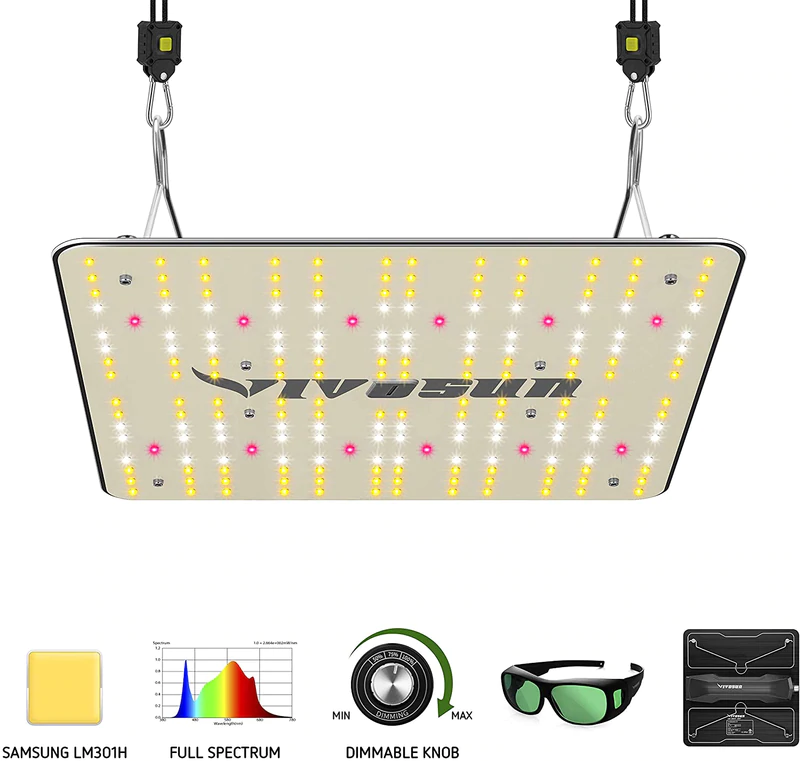
Features:
This LED grow light uses Samsung LM301H diodes, which are very durable. High energy efficiency of 2.75 μmol/J, lower cost and higher efficiency, consuming only 100W. More efficient than traditional HID lamps. Dimmable ballasts can adapt to the growing needs of plants at different times. The VS1000 Full Spectrum LED provides the best spectral coverage — more power for your flowers and maximum PAR output at all distances, plus super bright light your plants will love. The VS1000 eliminates the need for a grow light fan thanks to the unique exterior design of the power supply and vents. No fan means much lower noise.
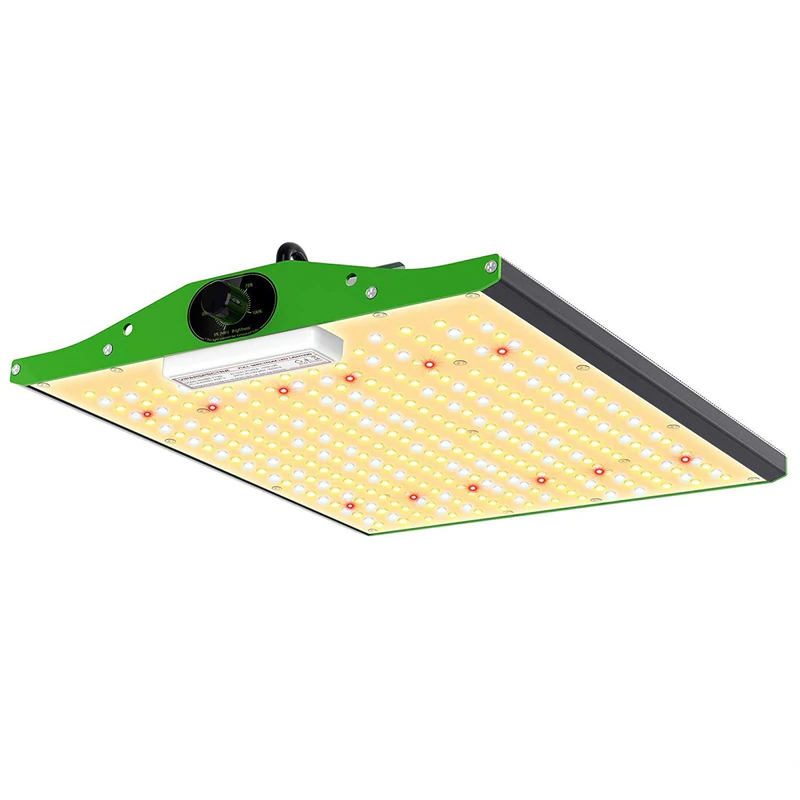
Features:
Noise-free grow light solutions are designed to keep your plants healthy as they would in natural sunlight. This is because LEDs emit full spectrum light, a combination of 3500K, 660nm and 7500K white light. Thanks to the latest SMD technology, the efficiency of the grow lights has been increased. With smart technology, light can penetrate deeper and promote overall plant growth. You can use dimmers to reduce operating costs and adjust the performance of light fixtures. It can adjust the light intensity from 0% to 100% in an instant. Built-in 300 SMD LED chips to ensure a service life of 50,000 to 100,000 hours, without worrying about any untimely expenditures during its life cycle.
Why Choose the LED Grow Lights?
— — Color variations of the LED grow lights are directly connected to the intended purpose.
Adding other colors to the spectrum, such as green, far-red, and deep blue aids this process by giving plants more information about their environment and overall resulting in higher quality plants (quicker growth, more secondary metabolite accumulation, etc). A spectrum that contains all colors is called a full spectrum and mostly resembles sunlight. If it has high proportions of green, the light will appear white to human eyes, and while not a crucial factor for plant growth, it does make the workaround of these lights easier and makes a visual inspection of the plants possible.
— — LED lighting systems can be configured to provide optimum photosynthetic photon flux density.
Photosynthetic flux density (PPFD) refers to the total amount of light that actually arrives at a plant surface. Higher PPFD levels generally translate into better plant quality and higher indoor crop yields. Because LED lighting systems operate at lower physical temperatures than traditional indoor lighting, LED fixtures can be placed closer to plant surfaces to generate those higher PPFD levels.
— — LED lighting produces larger plants and better crop yields.
Indoor cultivation that utilizes LED lighting is superior to crop production that relies on older artificial lighting sources, and in some ways, it may produce more bountiful harvests than outdoor cultivation which is subject to inconsistent amounts of sunshine and variations in weather patterns.
— — LED lighting is durable.
LED grow light system will generate high-quality light for more than 50,000 hours of use. LED lights are resistant to vibrations, shock, and impact from external objects. Their durability makes them ideal for exposure to weather, wind, and rain. They are even strong enough to be a good choice when there is a concern of vandalism, traffic-related impact, or on construction sites
Conclusion
Grow lights are a good investment unless you know your indoor plants only need very low light, or are sure to get enough natural light from windows. Obviously, there are enough options to suit every space, budget, garden and style. So, choose the light that works best for you and sparkle a little love in your indoor garden.
Best 400W Led Grow Lights for 4×4 Grow Tent: Top Deals & Guide
October 28, 2022
When the sun isn’t on your side, grow lights can come to the rescue. Whether you’re looking to get a leg up on vegetable growing season or just help your houseplants survive the winter, here’s how to find the best grow light for your needs and space.
How many watts should my LED grow light be for a 4×4 grow tent?
When choosing a LED grow light for a 4×4 grow tent, it is important to consider the size of the light. In general, it is recommended to choose a light with a wattage that is equal to or greater than the size of the grow tent. So, for a 4×4 grow tent, it is recommended to choose a LED grow light with at least 400 watts of power.
ECO Farm SP-400 Samsung Foldable Dimmable Full Spectrum LED Grow Light
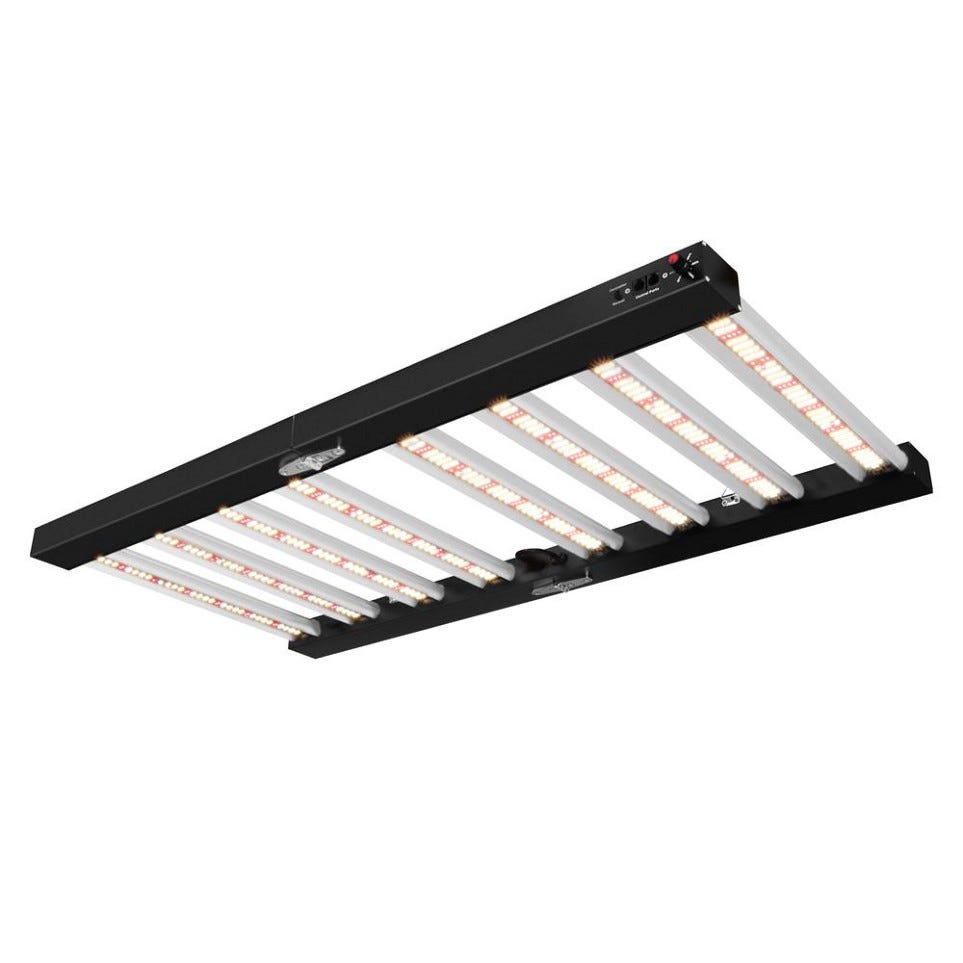
Features:
ECO Farm LED grow light is equipped with 1088 high-efficiency Samsung LM281B LEDs. It has a market lighting efficiency of 2.8μmol/J and an output of 2.5g per watt. The average PPFD is increased by 30%, and the actual power is 420 watts. Proven high-yield full-spectrum (lm281b LEDs (3000k+5000k) + RED 660nm + IR 730nm + UV 395nm), with enhanced deep red 660nm. Born for big buds, the plant responds quickly from seed to flowering, which speeds up the flowering time and increases the yield. The relaxed dimming design meets the needs of different growth stages of indoor plants. No fan, no noise. The aluminum light bar can better dissipate heat and keep cool, and at the same time spread the light evenly. Save you a lot of ventilation and exhaust costs. The most powerful daisy chain-up to 100 lights can be connected, the controller can be used, especially suitable for homes, planting tents, planting rooms, greenhouses, gardens, and hydroponics.
Kind LED X420 Grow Light For Indoor Plants
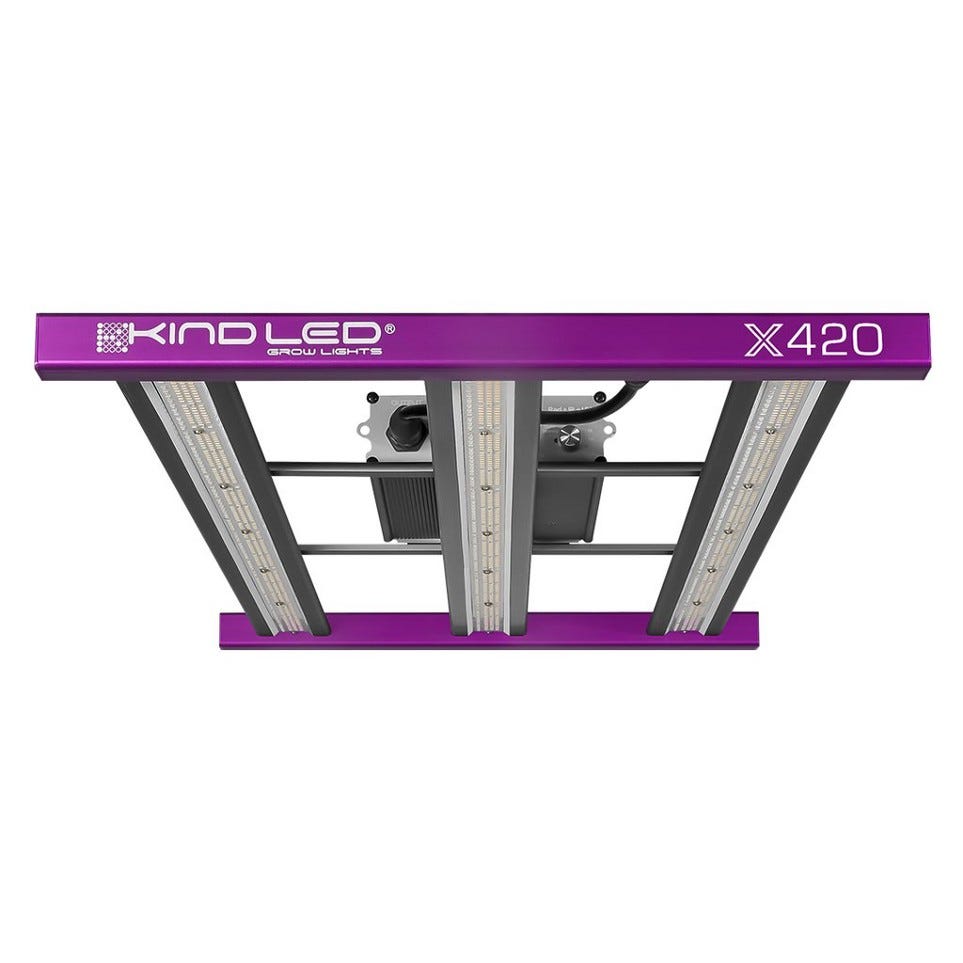
Features:
This Kind LED grow light combines great innovation with a new shape optimized for home growers. The full-spectrum diodes used by the White LED Company were originally designed for home and office use. Kind’s Targeted Full Spectrum is specifically designed for plants to maximize harvest weight and plant quality. You can have both ultraviolet and infrared rays, which are essential to increase flower development and increase the production of secondary metabolites, thereby increasing potency and terpenes. The external drive mount of the New X series can also reduce the light height by 60% (more growth space) and reduce the heat output by 25%.
EYE HORTILUX Ascend LED 450-EVS Grow Light
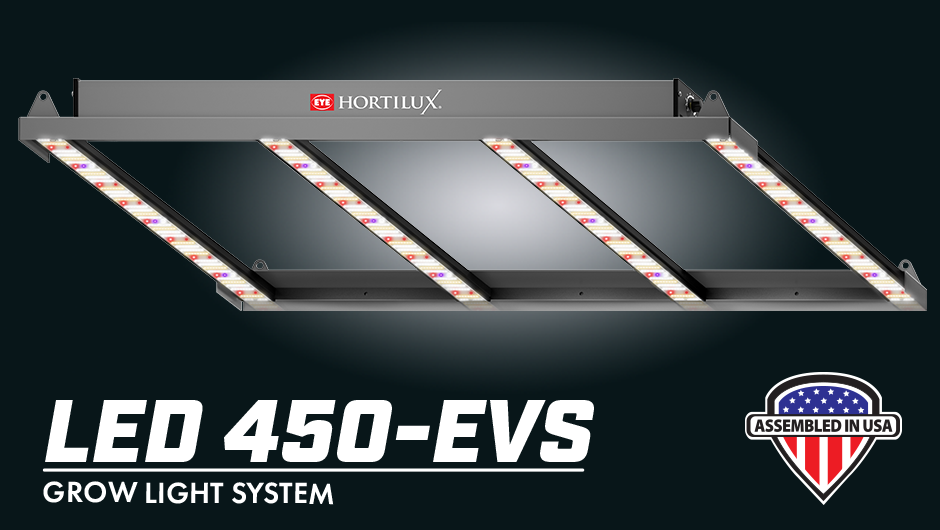
Features:
Our powerful LED extends the standard LED growing spectrum providing energy outside the PAR range to include ultraviolet (UV) and far-red, promoting stronger plant growth with heavier flowers. The LED 450-EVS was designed to lower the wattage and cost for lighting your veg space. The grow light provides a true full-spectrum, including UV and far-red, all in one fixture. This setup gives your plants the best chance to grow under LED lighting without sacrificing the benefits of natural sunlight. The 450W fixture includes an onboard dimmer for complete output control, wide distribution LEDs for uniform coverage, conformal coating to protect from dust and water, and sturdy construction. Use it for flower or even start-to-finish using the dimmer during veg.
Things to Consider When Buying LED Grow Lights
Power Supply
If you are considering growing plants that do not require much intensity or a high degree of absorption, you should choose from the products that do not draw much power or need more current to function.
If you are interested in vegetation that only grows when it absorbs a greater amount of light, it is better to select from the LEDs that suit the need.
Durability
When looking at the specifications of a LED grow light, it is necessary to check the materials used in its construction.
The elements should resist damage from stress and moisture, and there should be a protective layer on the body. Furthermore, all the electric components inside the body should have adequate insulation where necessary.
Cooling System
Most of the products overheat if customers use them for more than 14 hours a day. If the product you bring produces more heat than the limit, it will not only possibly burn your plants, but also has a negative impact on the unit itself.
Check if there is a sufficient built-in system for the heat sink. Generally, high-quality aluminum with ventilation holes or a sufficient number of fans is long-lasting.
Compare the PAR Values
Checking the Photosynthetically Active Radiation (PAR) of a product is also among the crucial aspects to remember. These radiations are beneficial to plants and act as an alternative to natural light. High PAR means more brightness level, which most of the plants love.
However, you must note that this quality does not necessarily mean that the light source is suitable. There should be an even distribution of this light so that no plant faces the inhibition in development phases. In this case, only those in the vicinity of LEDs will receive light and grow well, while the others will take a longer time or might die.
Programmability
The option to program certain features is something that proves to be extremely beneficial to the plant owners. They make your task more convenient by allowing you to adjust schedules and the specific wavelengths that your plants require. Just set the alarm for turning on and off the source, and ease the pressure of doing it yourself every day.
Price
It is better to note those options in the list that involve moderate to high costs. Why? Usually, LEDs are more expensive than other items such as fluorescent lights and there are fewer chances that they will be available at extremely reduced prices. It will also mean that they might not work for an extended period.
Thus, it might result in contacting the customer service or an electrician for the repair frequently, indicating more effort and bills. If you still want to buy a cheaper variant, make sure to check if it can last for a maximum of six to seven months and has a nice cooling system.
Conclusion
When it comes to LED grow lights, there are so many options on the market. We tried to provide as detailed a review as possible, with all the pros and cons of the product. However, if you think you would like to know more about a specific aspect, or would like us to review more of your selections, please contact us via a comment or email and we’ll get it done as soon as we can!
Buying Guide For the Best 800W LED Grow Lights of 2022
October 26, 2022
If you’re just a beginner in indoor growing, there’s a lot you need to know about this plant.
Since you’re growing plants indoors, you’ll need artificial light that’s bright enough to support the plants. I recommend you choose LED grow light products because they are efficient and have a higher output per watt. They last a long time and are generally less expensive to run. Compared to HID lights, LED lights are a more favourable choice.
Why Choose Full Spectrum LED Grow Lights?
Different LED Grow lights emit different wavelengths based on their spectral patterns. These different light wavelengths stimulate different stages of plant growth, so when choosing the right grow light, you must examine its spectrum for the type of stimulation you want. For example, LEDs that are great for vegetation may not be as effective for flower development.
But full spectrum LED grow lights can satisfy different stages of plant stimulation according to your needs, so you can use it for everyone. A full spectrum grow light is an adjustable LED light that emits different wavelengths of light similar to the sun. In other words, full spectrum light emits all wavelengths of light emitted by the sun.
Many plants require not only red or blue light, but all colors of visible light (even in limited quantities) to grow properly. For such plants, full-spectrum lights are the most suitable option. For example, some plants require different wavelengths of light at different stages of their growth, so full-spectrum light is recommended for healthy growth.
ECO Farm ECOD Samsung UV+ IR 800W Dimmable LED Grow Light
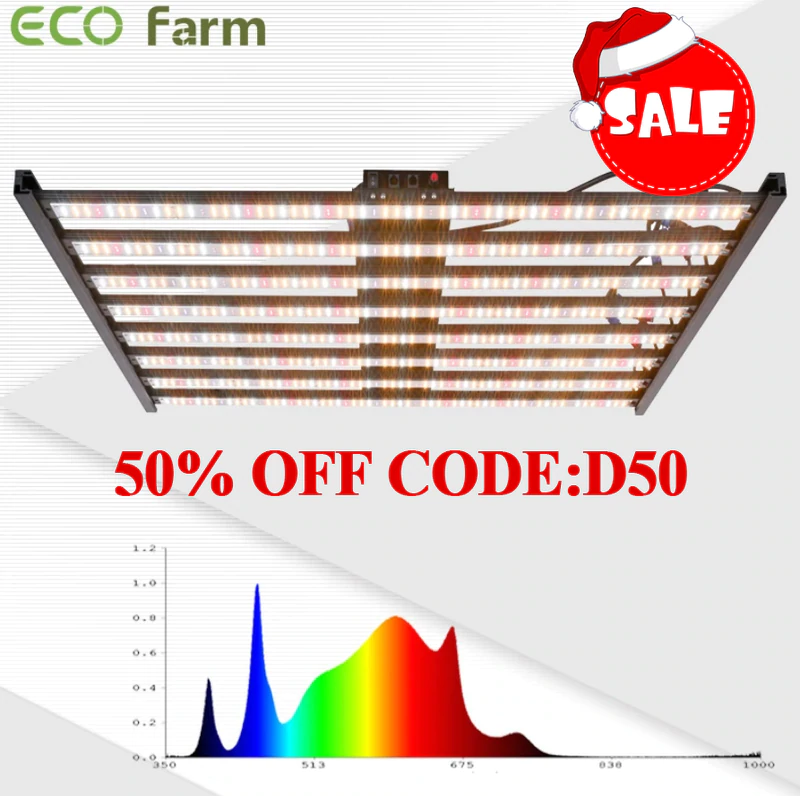
Features:
This ECO Farm LED grow light adopts the top quality equivalent diodes, producing a 800W PPF output of 2019.6 μmol/s and a PAR efficacy of 2.8umol/J, ideal for home and vertical farm planting. This full spectrum grow light meets the lighting requirements of every stage during the plant’s growth cycle. It consists of 660nm of red light, IR, 3000K and 6500K of the white light spectrum, providing plants in all stages from veg to flower with everything they need in the natural sunlight.LED plant lights enable cultivators to produce density buds, the 8-bar configuration allows widely application in the home grow (grow box and grow tents), climate rooms, commercial growing (horizontal and vertical), greenhouse cultivation, vertical racks, hydroponics.
Grow Light Science PROGROW 850 850W LED Grow Light
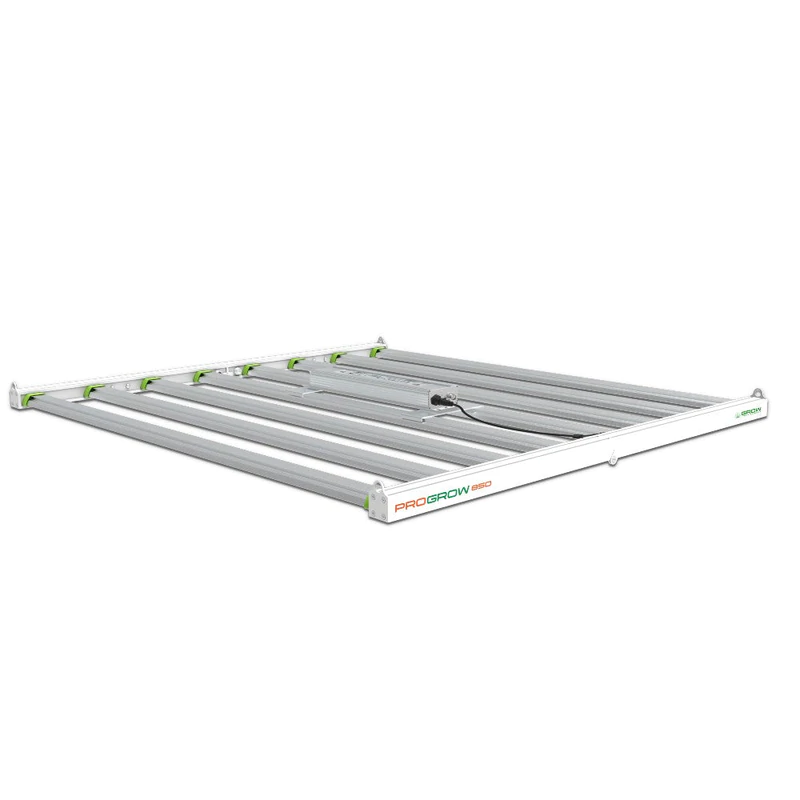
Features:
Grow Light Science LED grow light is a full cycle overhead lighting solution for commercial or residential plants cultivation. The 850’s form factor allows for expandability and multiple grow room and grow tent configurations where photosynthesis and yield maximization are the goals. PROGROW 850 provides high PPFD levels and can be used with CO2 supplements. Top light output (PPF), spectral distribution and efficacy will deliver amazing results with little impact on your wallet. PROGROW 850 will deliver PPFD levels of over 1,400 umols/m2/s, either individually or in arrays of multiple cells. We recommend that all growers conduct research and trials within their growing space to design the best combination of inputs.
Spectrum King Phoenix 840W LED Grow Light
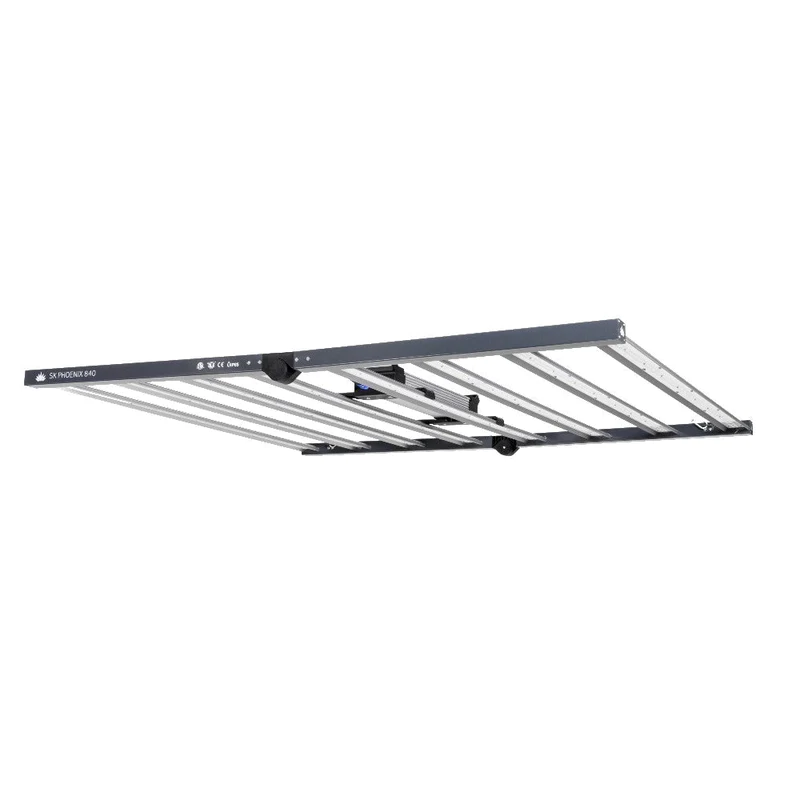
Features:
Spectrum King’s Phoenix 840W is ideal for photon-hungry crops that can handle strong light. With 16% less wall power than standard HPS fixtures, the 840 provides some decent output compared to other fixtures while still saving electricity and heat. Spectrum King’s custom spectrum is tested and customized to maximize plant and flowering cycle growth. The intensity of this dimmable light can be as low as 10%, enabling growers to simulate a sunrise/sunset effect. Spectrum King’s innovative Cryo-Therm cooling technology features an ultra-thin profile that maximizes airflow and minimizes microclimates. The Phoenix 840 grow light is optimized for single or multi-level planting close to the canopy.
Buying Guide For LED Grow Light
As the name suggests, LED grow lights utilizes modern LED chips in a fashion that introduces suitable growing light for plants. The quality obtained from different LED grow lights are different and that in turn affects the growth and sustainability of the plant. If you are going to set up an indoor growing platform, you should go through our top picks for the best LED grow lights.
These options are shortlisted from hundreds of different choices based on various crucial factors such as light intensity, panel size and overall quality of the LED grow light. Although, you should still consider the following mentioned properties briefly to understand their virtue regarding different types of applications. After going through our buying guide for the best LED grow light, we can assure you that you will be able to pick up the best option for yourself.
The Intensity of LED Lights
As we mentioned earlier, the intensity of light produced by the LED lights is one of the most crucial factors and directly affects the quality of plants growing in the light. As different types of plants have varying photon requirements, you need to select the correct intensity of light over the plants. For best results, you should choose a high capacity LED grow light that can be dimmed as per requirement.
LED Light Spectrum
The spectrum of LED lights refers to the different wavelengths of light produced by the LED. Different spectrums of light must be fed to the plants in different growing stages. In case you want to use the same LED grow light for different types of growth stages, you should go with a full-spectrum option. Otherwise, you can select between single spectrum panels suitable for the single application.
Coverage Area
The coverage area of LED panels represents the area that can be illuminated by the panel at once. To put in simpler words, the area of the plantation unit must be equal to or smaller than the coverage area of the LED grow light for optimum results. If a part of your plantation platform is outside the illuminated area, it will cause non-uniform growth of the plant that will also affect the whole plant. You can also install certain lenses to increase or decrease the coverage area of your LED grow light.
Warranty
Lastly, we will recommend you to take a closer look at the warranty period allotted by the brand for the given LED grow lights. The LED lights can fail at any time on the panel and you cannot simply replace a single LED from the section. As buying a heavy-duty LED grow light is quite expensive, you should always opt-in for a longer warranty period. Thus, you will get full assurance from the manufacturer about the durability of the panel as well as LED lights.
Conclusion
Whether you’re a houseplant lover or someone who’s passionate about growing your own food, indoor grow lights are invaluable tools. No matter where you live, high-quality grow lights allow indoor plants to grow year-round. Most importantly, they’ll help you grow the healthiest, happiest plants you’ve ever had.
I hope this article gave you a better idea of which plant lights are best for your indoor gardening needs. Happy gardening!
Best 700W LED Grow Lights for Houseplants and Seedlings
October 25, 2022
Thinking about seed starting or growing indoors? Here’s what you need to know about indoor grow lights for starting seeds, gardening inside, or houseplants.
Grow lights help you start part or your entire outdoor garden indoors during cold winter days. Grow lights provide the proper light for rapid plant growth indoors.
Seed Starting or growing vegetables and flowers indoors requires grow lights and choosing the best grow lights is very important for a few reasons.
Firstly, the the type of plant you will be growing. some lights are better for some plants than others some plants need more light while others need less.
Secondly, the cost of the grow lights vary greatly from LED to CFL. LED’s have higher up front cost but consume less energy while the CFL’s cost less and consume more energy than LED.
Thirdly the size of the grow area will also determine the type of grow lights you should get to give you the best result.
Having a cheap grow light is a huge savings in terms of cost. For instance the initial cost of buying an LED grow light might be high but in the long run you save money as a result of Electricity Savings for the long term (led light bulbs consumes far less electricity than other light bulbs).
ECO Farm ECO Z Lite 750W LED Grow Light
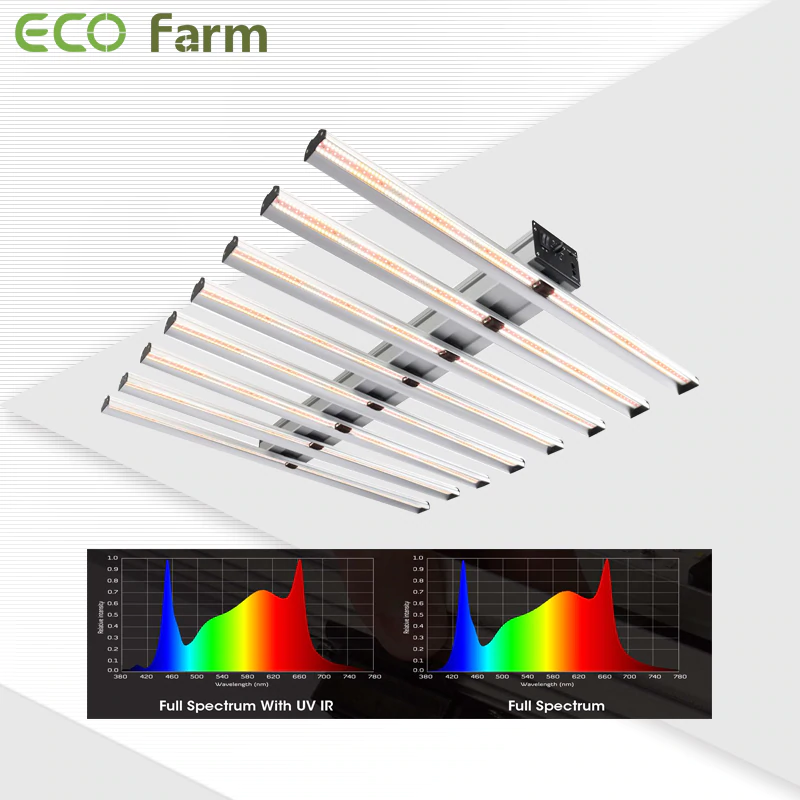
Features:
This ECO Farm LED grow light features an 8-bar design for more even and complete canopy coverage. Equipped with high efficiency diodes with extremely low thermal resistance. Grow lights are flicker-free and dim, with a lifespan of 50,000 hours. LED grow lights consume 750 watts at 2069 µmol/s for a satisfactory PPE of 2.8 µmol/J, ideal for 6 x 6 ft. plant areas or 5 x 5 ft. flowering areas. Each full spectrum LED grow light uses a custom made 2100 diodes. The abundance of wavelength types is consistent with the spectral range of plant photosynthesis. It concentrates specific wavelengths of light to illuminate crops evenly, controlling plant height and plant nutrients.
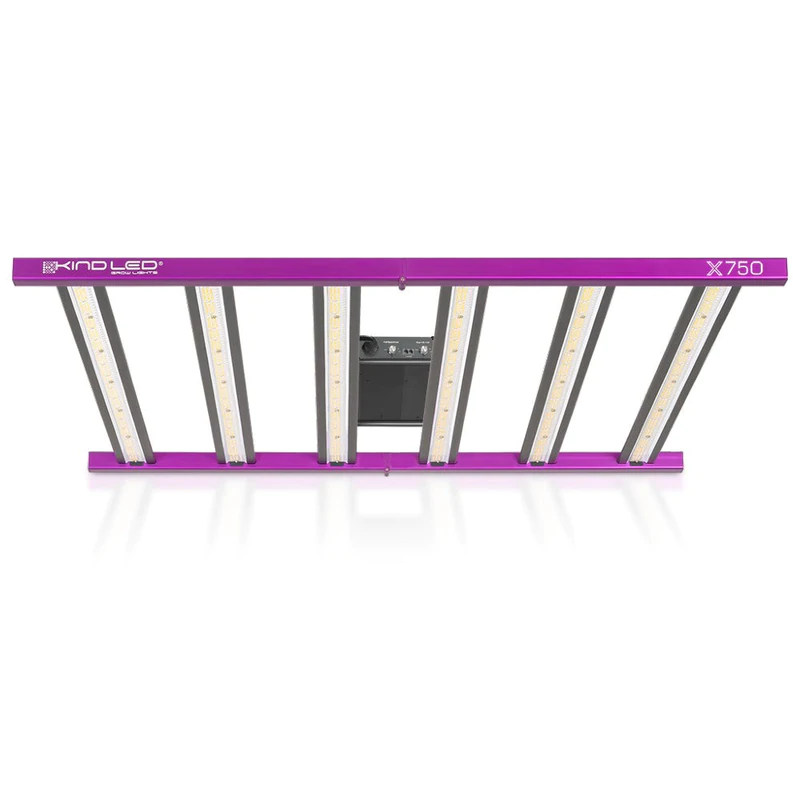
Features:
Kind LED grow light uses top-of-the-line Osram and Phillips diodes to produce targeted full-spectrum light as well as UV and IR to enhance your plants during flowering. The KIND X750 uses the full spectrum white LED diodes used by top LED companies. Kind’s Targeted Full Spectrum is designed for plants to maximize harvest weight and plant quality. Our spectrum is the result of hundreds of thousands of hours of field testing in the Northern California medicinal plant industry. With 750 watts of power and a 4' x 4' footprint, the X750 is powerful enough for commercial growers while still being compact enough for single planting.
RayonLED GLMF-720W FOLDABLE LED Grow Light
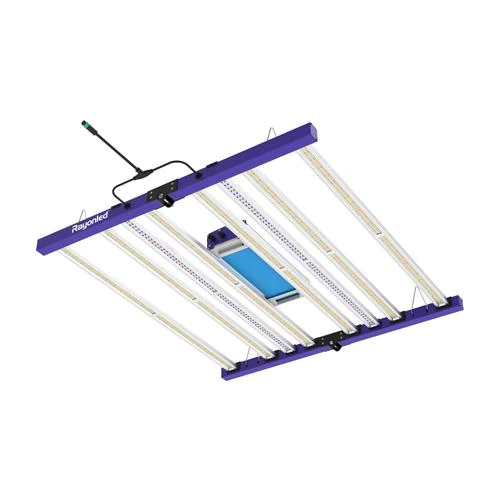
Features:
With its impressive expertise in LED technology, this medical-grade device has everything to appeal to hobby and commercial growers. The RayonLed grow light is designed to replace and surpass the results of 1000W HID fixtures. What’s more, the fixture has a dedicated UV-IR strip that can be controlled independently. From spectrum to certification, it’s engineered to compete with the top grow lights on the market. Passively cooled light bars provide full spectrum, broad coverage light for long-term growth. High output 1944 µmols PAR! and an impressive efficacy of 2.7 µmol/s per watt. The unit features UV and far-red light strips to provide the most complete spectrum on the market today! IP65 certification allows lights to function and last in even the wettest grow rooms
How to Choose the Best Grow Light for Your Indoor Garden
Grow lights provide a convenient, economical source of artificial sunshine, so your seedlings, indoor herb gardens, and houseplants can thrive throughout the year.
The lights and all-inclusive kits are easy to use, but there’s a huge variety of lamps to choose from.
From LED strips to fluorescent tubes, each has its own characteristics and strengths. And a basic understanding of their features can help you make a more effective decision when purchasing.
Let’s dig into the details a bit.
The Electromagnetic Spectrum
The sun emits all the frequencies found within the electromagnetic spectrum, including those of visible light — violet, indigo, blue, green, yellow, orange, and red.
Blue — Blue is the first color absorbed by plants and is essential at the beginning, or vegetative, stage.
Purple — Purple also helps in the vegetative stage, although purple by itself does not provide effective energy for photosynthesis.
Green — Green is primarily reflected, but small amounts are retained and contribute to energy conversion.
Yellow — Yellow is the least effective for the purpose of photosynthesis.
Red — Red is needed in the mature, flowering stage for blooms to form and is most effective when combined with blue. Red alone should not be used in the early, vegetative stages.
White — White is the combination of all colors in the visible light spectrum and can be used effectively for all stages of a plant’s development.
So, for seedlings and leafy green vegetables, higher spectrum bulbs in the blue range are required.
But if you want plants to flower and set fruit, you’ll also need low spectrum red colors.
Or, you can make things easy. Use a full spectrum, white bulb to satisfy all stages of cultivation.
The Kelvin Scale
The Kelvin scale ranges from 1,000–10,000 and indicates a color’s temperature — the higher the Kelvin value, the closer a lamp’s color is to natural sunshine. Degrees of Kelvin are indicated by the capital letter K.
Ratings below 3500K typically have a warm value, showing an amber tint, while those with a higher rating get closer to a pure, or cool white color.
For leafy vegetative growth, a rating around 6500K is the ideal. But to generate flowers and fruit, plants require a period of exposure to warmer hues at approximately 3000K.
Lumens vs. Watts
It used to be that a bulb’s brightness was indicated by wattage. For example, a 100-watt bulb gave one and a half times the luminosity of a 40-watt bulb.
But due to the advent of energy efficient bulbs, wattage is no longer a good indicator of brightness. Wattage simply shows the amount of power drawn to produce a lamp’s brightness — which is now commonly indicated by lumens instead.
For example, an energy-efficient LED of 1,600 lumens has the equivalent brightness of one 100-watt bulb — but it only consumes up to 22 watts of power. And a comparably bright CFL bulb will use around 26 watts.
Basically, the higher the lumen value, the brighter the light will be. For seedlings, approximately 2,000 lumens per square foot is adequate. Flowering crops can require as much as 10,000 lumens per square foot.
Conclusion
Grow lights give you the advantage of growing a variety of crops in any climate at any time of year. You also benefit from faster growth and improved plant quality.
But to determine the right indoor LED grow light for your plants, you must consider several of the factors above. Thanks for reading!
ECO Farm MB660 Foldable Grow Light Bar VS RayonLED GLMF-640W FOLDABLE LED Grow Light
October 21, 2022
Many homeowners and renters are turning to indoor growing to enjoy year-round plant life, enhance their gardens, and even grow their food. To grow successfully indoors, you need plenty of light. LED lights are a cost-effective way to improve your indoor plants, even when you’re growing in low light or in winter. What are the best LED lights for growing? We’ll walk you through our top picks and help you choose the best LED lighting for you.
Can seeds be grown with LED lights?
All users with the right LED grow lights can start growing a plant or flower from seed. For this, it is necessary to consider that the grow light should have a broad spectrum in its operation.
This means that this tool should consider the growth stage from the seeds of any plant or flower. Even many people can combine an LED grow light with a certain growing procedure such as hydroponics.
Anyway, the most important thing is the features that each LED grow light can offer. In the best cases, the same LED grows light can fully cover all stages of flowers and plants.
Should I turn off the grow light at night?
On this occasion, experts strongly recommend applying an environment similar to that in which plants and flowers are found in nature.
All plants and flowers in nature are exposed to a period of darkness at night. So leaving lights on 24 hours a day and every day of the week can be detrimental to any plant or flower.
Even different plants and flowers require a period of darkness and a period of light that are different. For this, some guidance should be consulted about the periods of darkness needed by plants and flowers. Applying this accurately allows for natural and efficient growth.
ECO Farm MB660 Foldable Grow Light Bar
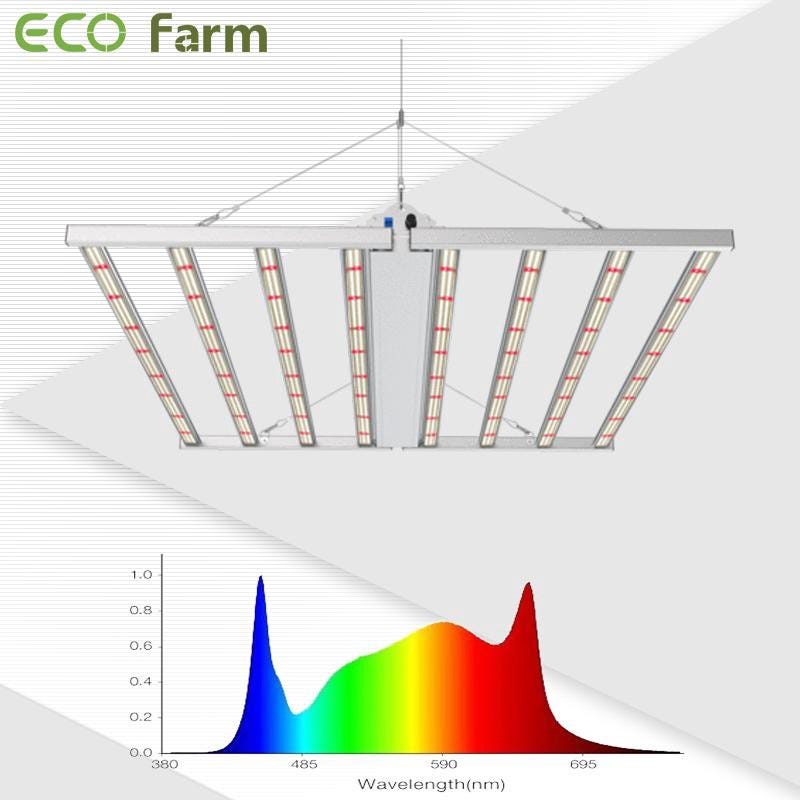
Features:
The UV+IR bars of this ECO Farm LED grow light can increase your plant THC content. UV light causes the plant to create more resin to protect itself, which means higher THC and CBD levels. This LED grow light utilizes the latest technology on the market–from intensive research for optimum performance, to customized spectrums to achieve the highest yields possible. This grow light is the most powerful commercial-grade LED grow light on the market. No fans = silent & noise-free operation. The full spectrum(2112pcs LM301b 3030 White chips+48 Osram 660nm Red chips) allows you to drastically increase yields and quality. Using this LED grow light is a great way to save on lighting for larger grow rooms and greenhouses.
RayonLED GLMF-640W FOLDABLE LED Grow Light
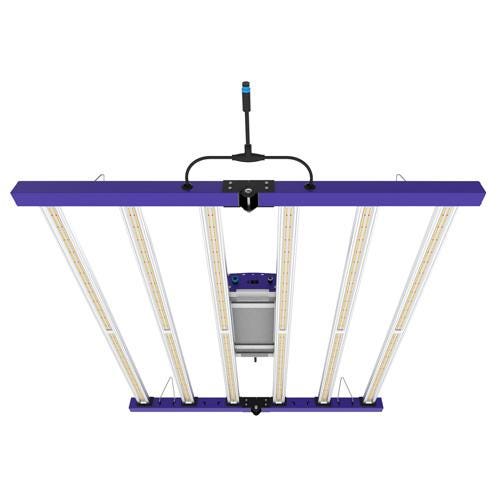
Features:
This Rayonled LED grow light has everything to appeal to hobby and commercial growers with its impressive expertise in LED technology. The GLMF640 is designed to replace and exceed the results of 1000W HID luminaires. From spectrum to certification, it’s engineered to compete with the top grow lights on the market. With a high output of 1,728 μmol PAR and impressive efficacy of 2.7 μmol/J/W, this grow light bar provides full spectrum, broad coverage light for long-term growth. IP65 certification allows the light to function and last in even the wettest grow rooms. And independent strips and drivers ensure that even if something goes wrong, the lights can be repaired without losing production of the entire fixture.
Factors To Think Before Buying Led Grow light
When buying a led growlight, people usually don’t pay much attention to their needs and requirements. They head straight towards the market, pick up any led growlight and buy it. However, this is not a good idea as there are many factors that you need to consider before buying a led growlight. Here are some of the most important factors that should be considered when buying a led growlight:
Durability: The first thing that you should look into is durability. The product should be made from high-quality material so that it lasts for a long time and does not face any problems during its use.
Quality: Before buying any led growlight, check its quality and features first. It is not worth buying if it has all the features but is low quality!
Price: Price can also help you choose the best led growlight. You should always check whether the price matches your budget or not!
Customer Reviews: If you want to know more about a certain product before purchasing it, check out customer reviews online! Many websites are available online where people write about their experience with certain products.
Know Your Needs
Before going for any purchase, it is important for you to know your needs properly. You should know what type of led growlight you want to buy and how much money you want to spend on that particular item. Knowing your needs well, it will help you make an informed decision as well as prevent you from making mistakes while shopping online or offline.
Consider Your Budget
The money you can spend buying a new led growlight should be determined before anything else. There are many types of led growlights in the market today; some are more expensive than others. It is important that you know what you can afford and stick to it so that you will not get confused when looking at the different models available in the market today.
First, the price of the led growlight should be affordable. The price should not exceed your budget. You should also consider whether the quality of the product is good or not.
Check Reviews
When purchasing anything online, most people check reviews before buying anything because they want their money’s worth and do not waste it on something they don’t like or don’t need. So, before buying anything online, it is better to check reviews on websites such as Amazon and other e-commerce sites to get an idea about how well-received a particular product has been by other customers who have already bought it before us.
Read Descriptions Carefully
The description should include information about what the led growlight does and its effectiveness at doing that task. If there are any negative comments about an item, check them out to see if there is any truth behind them or if they’re just opinions of people who don’t like the product.
Buy From Trusted Sellers
Try to avoid buying from untrusted sellers. If it’s too cheap, there may be something wrong with the product, or something else might be missing. Make sure that you buy from a trusted seller who has great reviews on their led growlight and services before making any purchases.
Check The Return Policy
Always check out the return policy before buying any led growlight online because some items have limited returns while others don’t give refunds. This is especially important when making large purchases since they can be difficult to return if they don’t work properly or fit into your home properly.
Conclusion
As we all know, we all dream of buying the best items. However, this is not always the case. Getting the best LED grow lights that will work well in your home can be tricky. So, following these guidelines will make your purchases more prominent and better.
Follow the instructions above and you’ll be sure to buy the right item. You can consider the minor and major details in our list and you will get your favorite item in no time. Use this item as your shopping reference and you’ll get the best in no time.
